OPAC
Search results
To search the OPAC you can either choose to enter your search words in the box at the top of the OPAC or click on the “Advanced search” link to perform a more detailed search.

Note
For more on searching check the Searching chapter in this manual.
Results overview
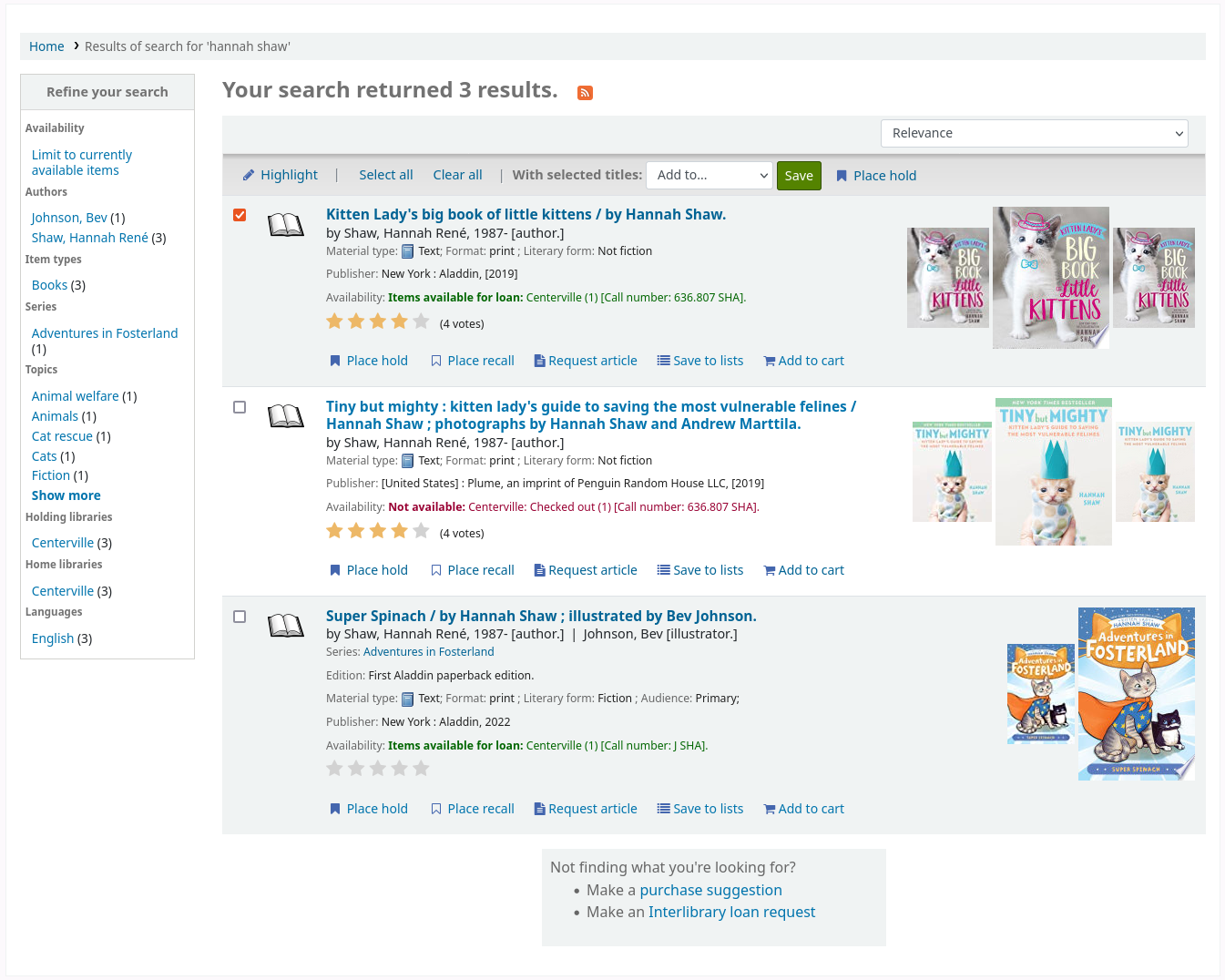
After performing a search, the number of results found for the search will appear above the results.
By default, the search results are sorted based on the OPACdefaultSortField and OPACdefaultSortOrder system preference values. To change the sort order of these results, you can choose another sorting method from the drop-down menu on the right.
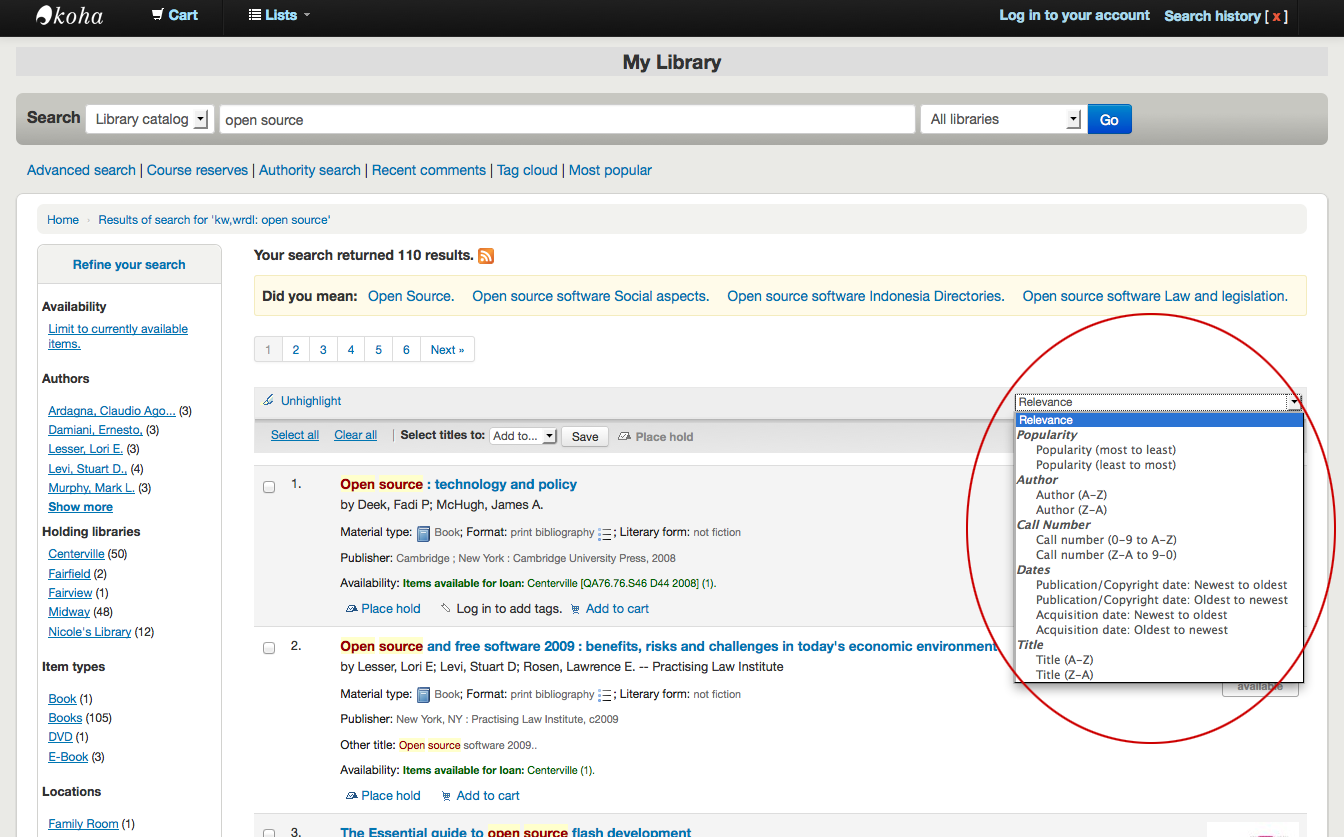
Under each title in the results list, there will be a series of values from the record’s leader (field 000).

Note
These values have nothing to do with the item types or collection codes you have applied to your records or items. This data is all pulled from the record’s control fields.
This can be turned on or off with the DisplayOPACiconsXSLT system preference.
Below each title, there will be the availability for the items attached to the record.
Note
Even if you filtered on one library location, all locations that hold the item will appear on the search results.
Avertissement
An item’s hold status does not affect whether or not the item is “available” until the item is in “waiting” status. Items with on-shelf holds will show as available until a staff member has pulled them from the shelf and checked the item in make it show “waiting”.
If any enhanced content system preferences are turned on, there may be cover images next to the search results.
If Did you mean? options are set, there will be a yellow bar across the top of your results will other related searches.
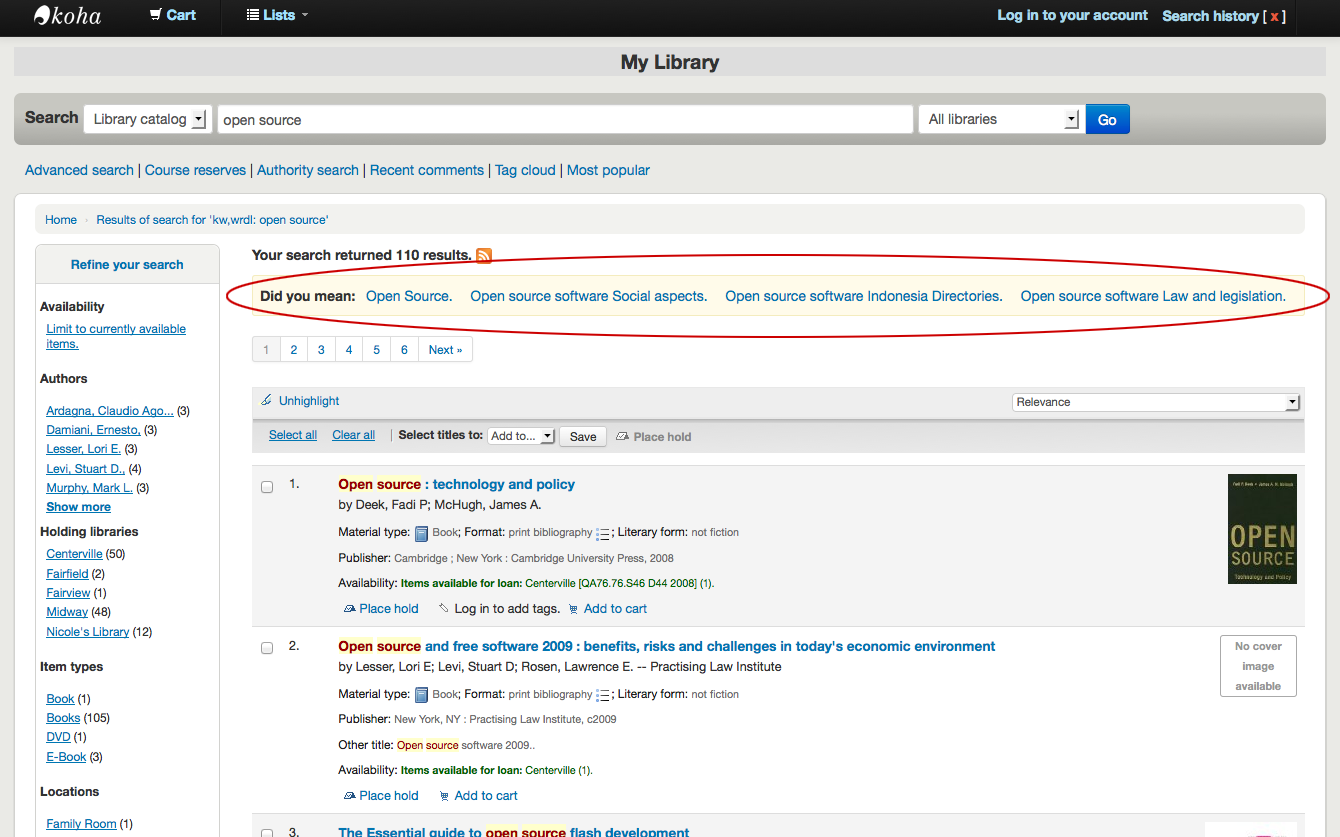
If you performed an advanced search you see an option to go back and edit your advanced search blow the list of results pages.
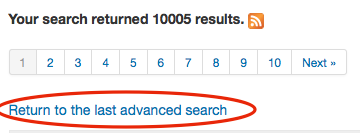
Filtres
To filter your results click on the links below the “Refine your search” menu on the left of your screen
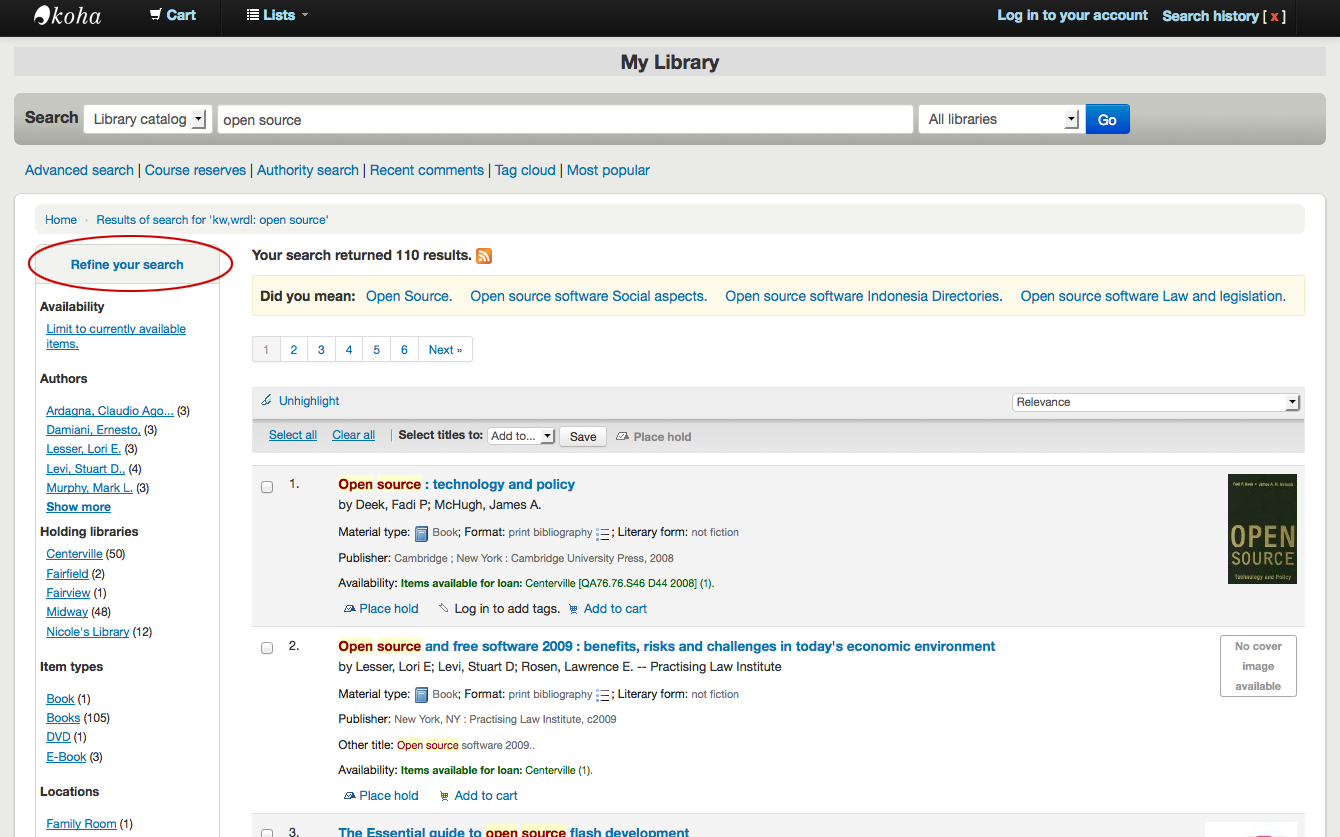
Depending on your setting for the DisplayLibraryFacets system preference you will see filters for your home, holding or both libraries.

Après avoir cliqué sur une facette, vous pouvez supprimer ce filtre et revenir à la liste complète des résultats en cliquant sur le petit “x” qui apparaît sur la droite de la facette.
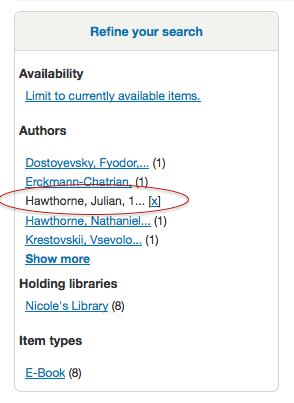
Search RSS feeds
You will be able to subscribe to your search results as an RSS feed by clicking the RSS icon in your address bar or next to the number of results. To learn more about what RSS feeds are check out this tutorial video.

L’intérêt de vous abonner à un flux RSS consiste à être informé des nouveaux documents qui s’ajoutent dans le catalogue dans le domaine de votre choix.
Bibliographic record
Lorsque vous cliquez sur un titre des résultats de recherche, vous serez basculé sur la notice bibliographique détaillée. Cette page est organisée en plusieurs parties.
En haut de l’écran s’affiche le titre et le GMD:
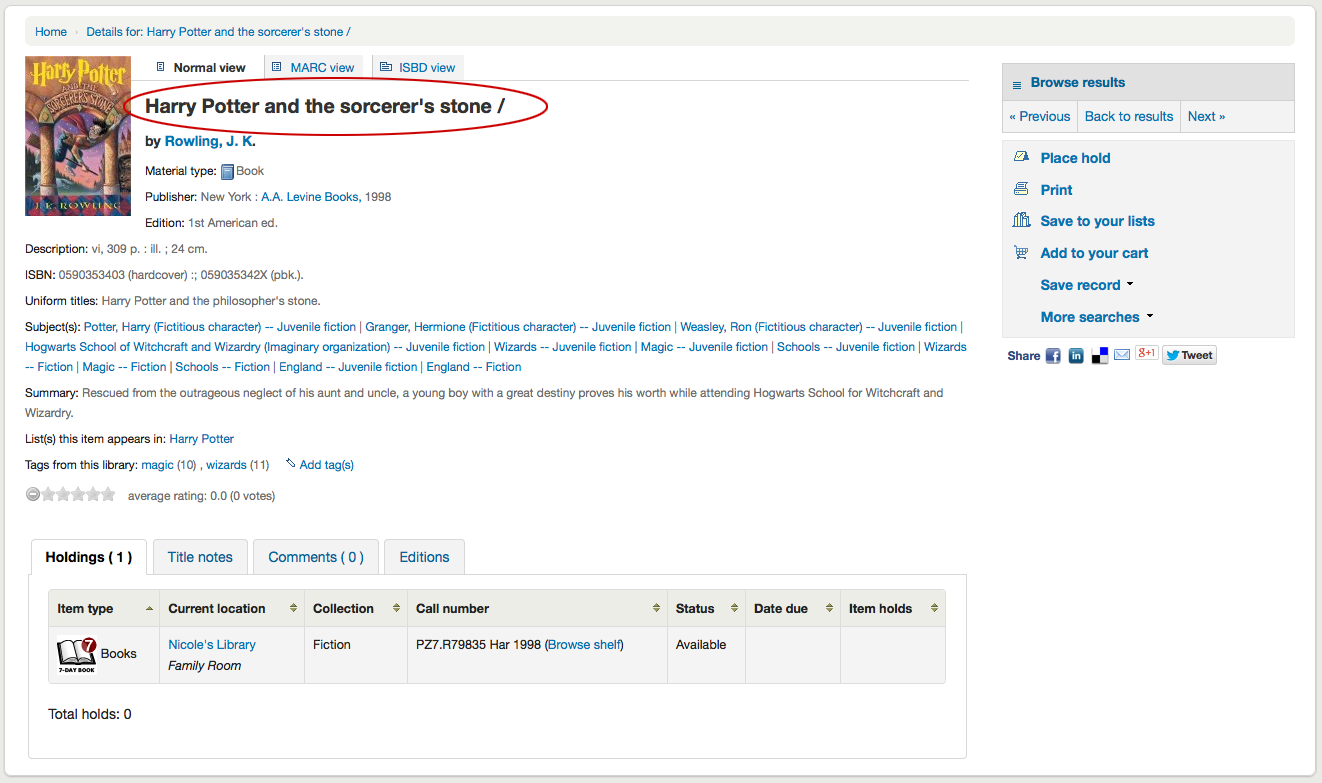
Le nom des titres est affiché juste en dessous. Ils sont définis dans les champs 1xx et 7xx. Si vous cliquez sur l’auteur, ceci lancera une recherche de tous les documents de cet auteur.
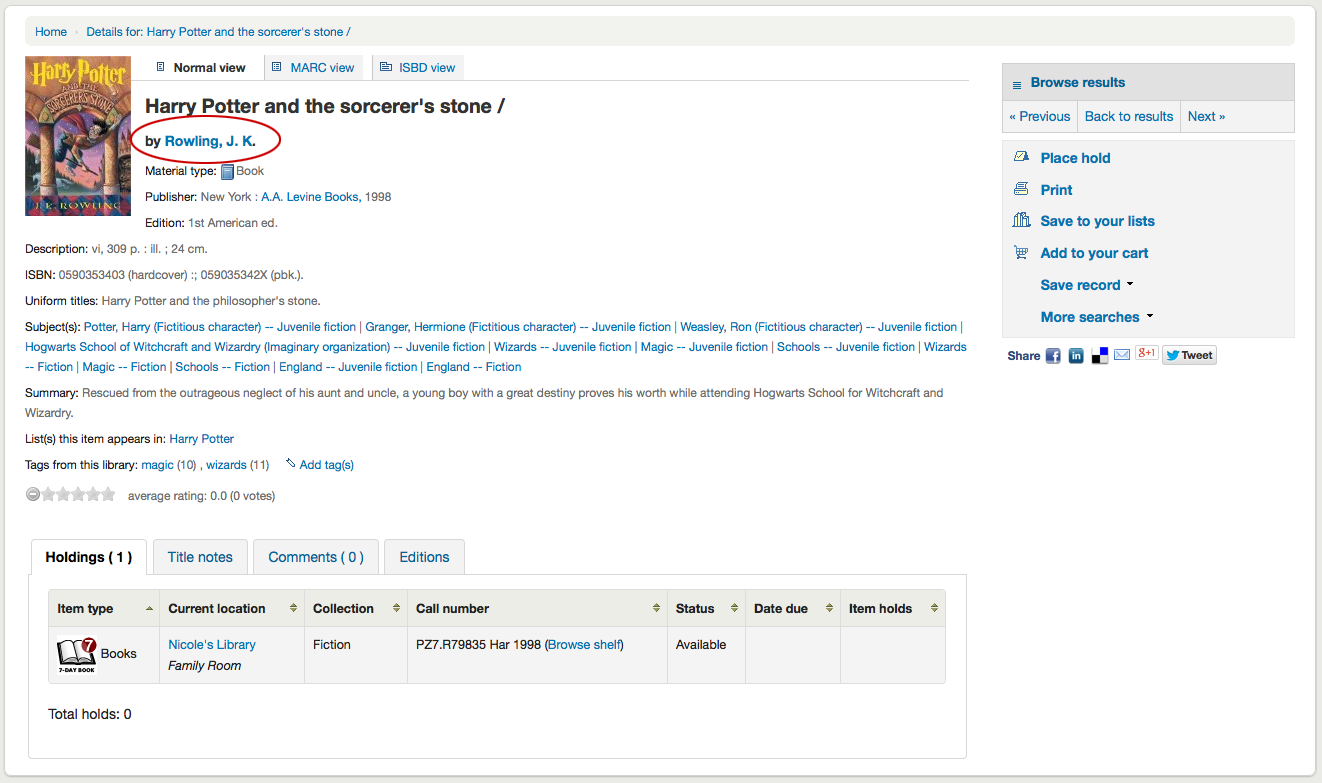
Si vous avez un fichier d’autorité, vous verrez une petite loupe à droite des autorités de l’auteur (ou des autres). Si vous cliquez sur cette loupe, cela vous basculera directement sur la notice d’autorité.
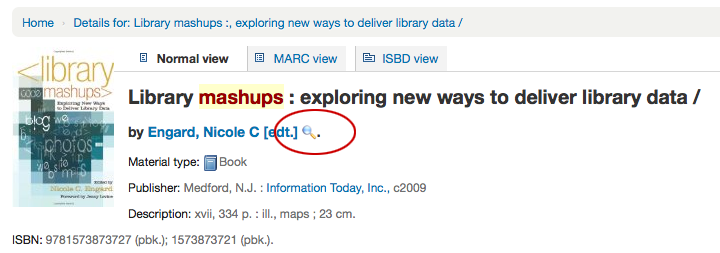
If you have your DisplayOPACiconsXSLT preference set to “show” you will see a material type that is determined by values in your fixed fields (learn more in the XSLT material type icons cataloging guide.
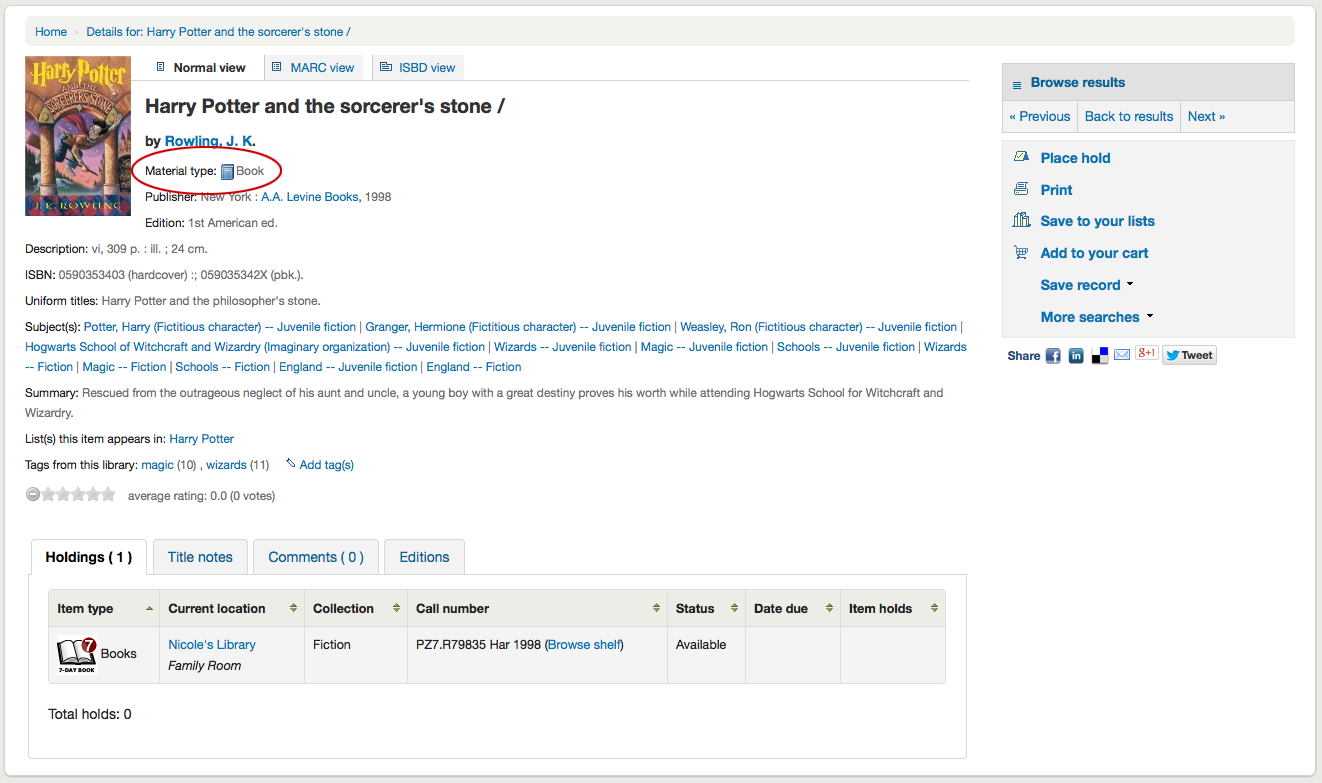
Vous verrez ensuite les zones de description de la notice:
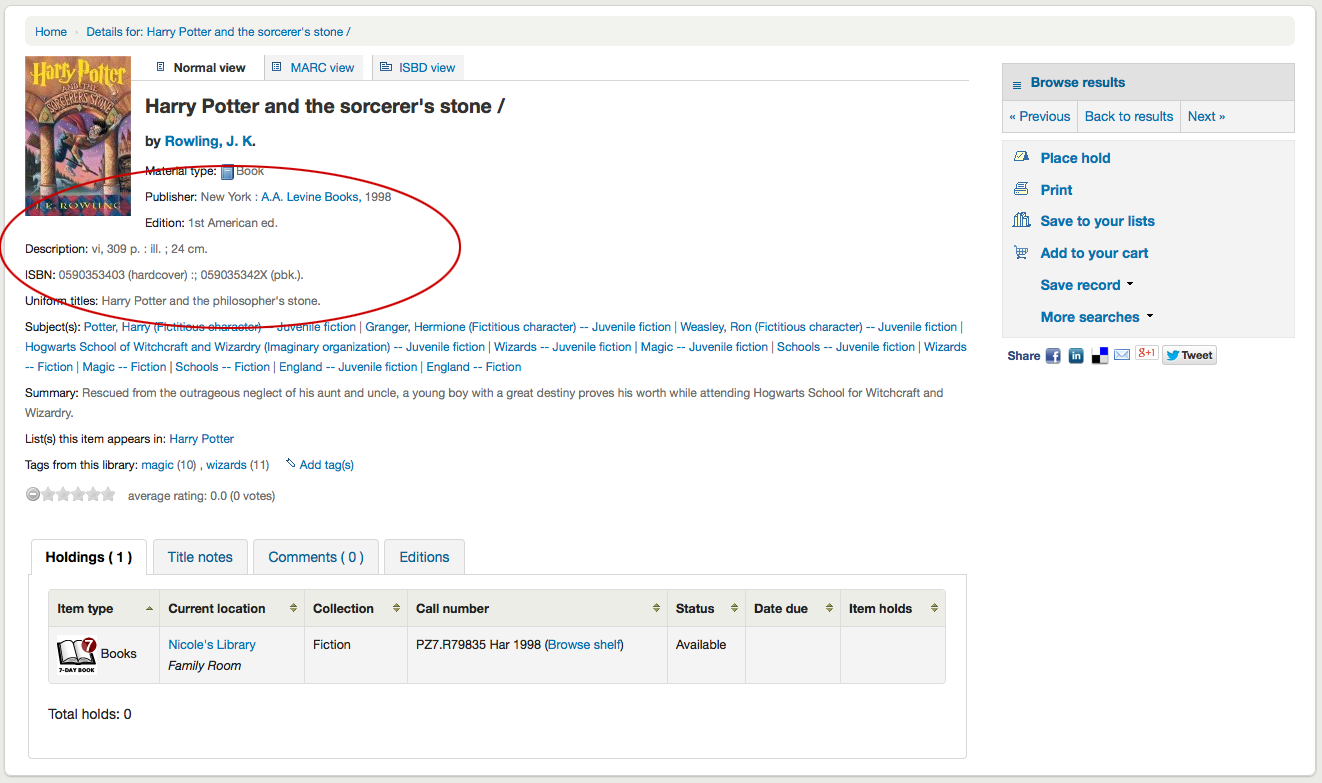
Parmi ces informations, vous trouverez les vedettes sujet sur lesquelles vous pouvez cliquer pour rechercher d’autres titres associés ou des sujets similaires
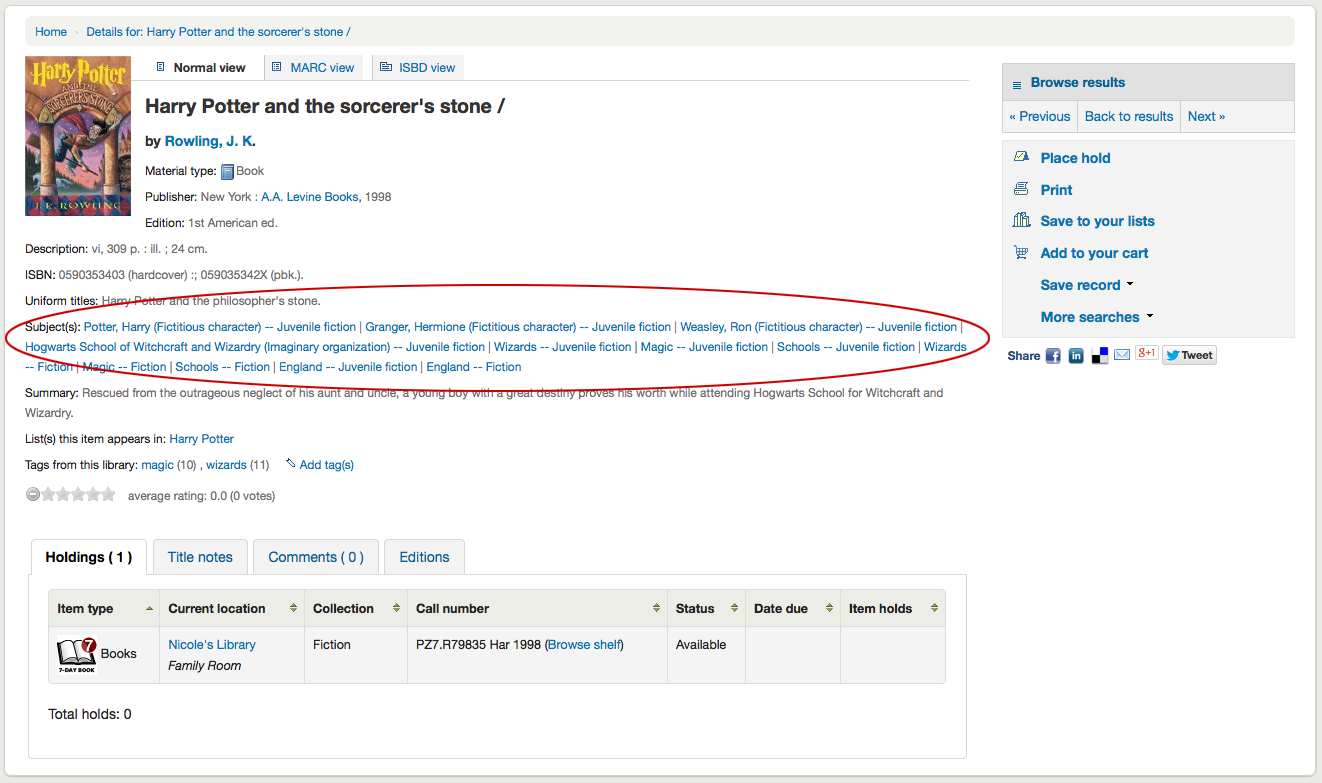
If your record has a table of contents or summary it will appear next to the “Summary” or “Table of contents” label
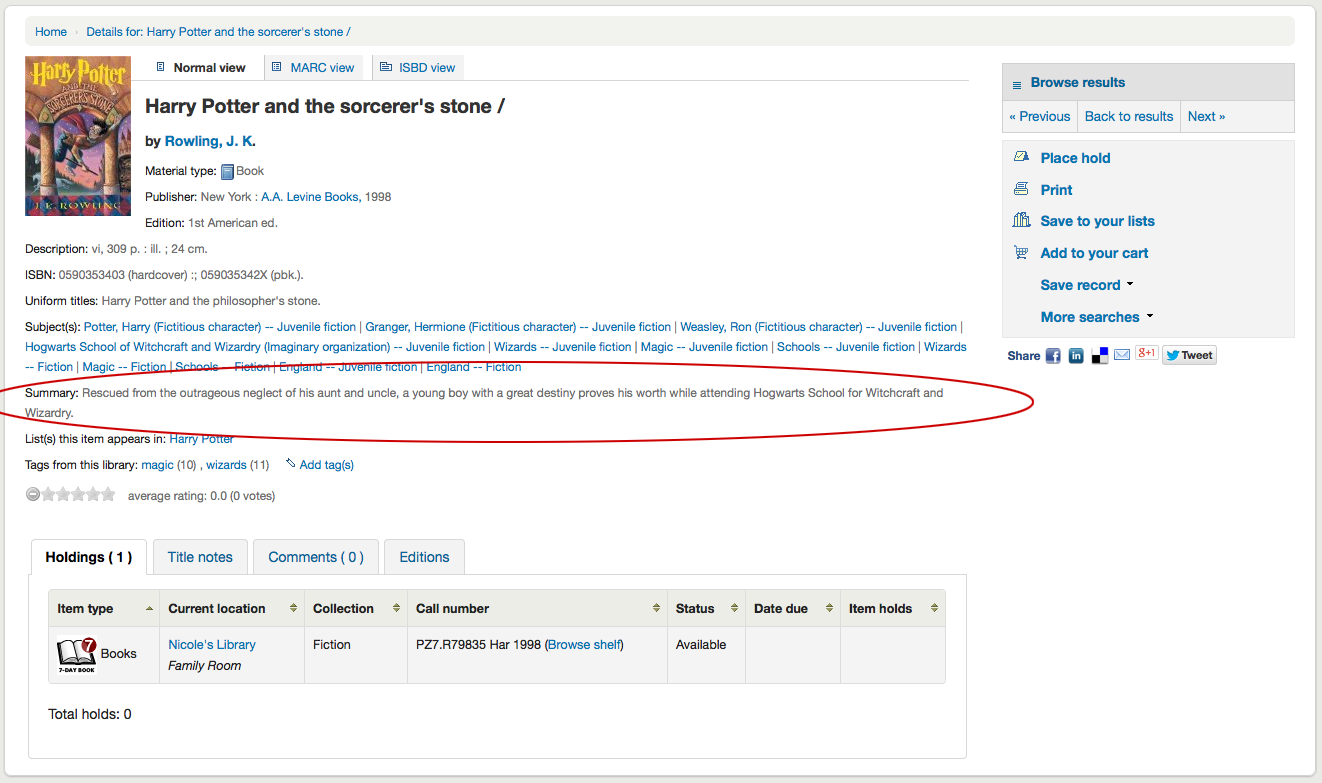
If your record has data in the 856 fields you’ll see the links to the right of the “Online resources” label

Si le titre que vous êtes en train de consulter est sur une liste publique, vous verrez une liste à droite de la mention “Liste(s) où l’exemplaire apparaît”. Et si votre notice est associée à des tags (mots-clés), ils apparaîtront sous la mention “Tags de cette bibliothèque”
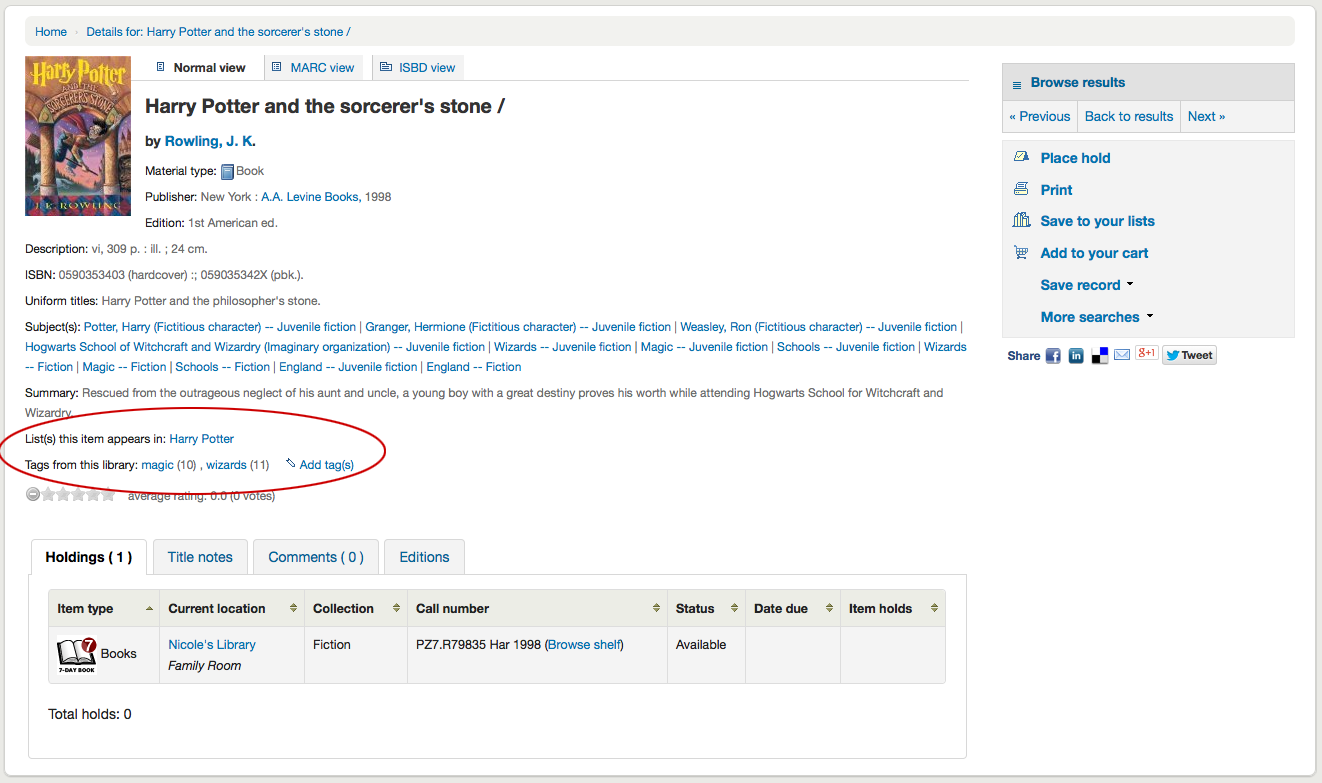
Dans les onglets situés sous les détails de la notice, vous trouverez toutes les informations de l’exemplaire

Note
You can customize the columns of this table in the “Table settings” section of the Administration module (table id: holdingst).
Any notes (5xx fields) that have been cataloged will appear under “Title notes”

If the bibliographic record is linked to a subscription in the Serials module, there will be a “Subscriptions” tab with the subscription and issues information.
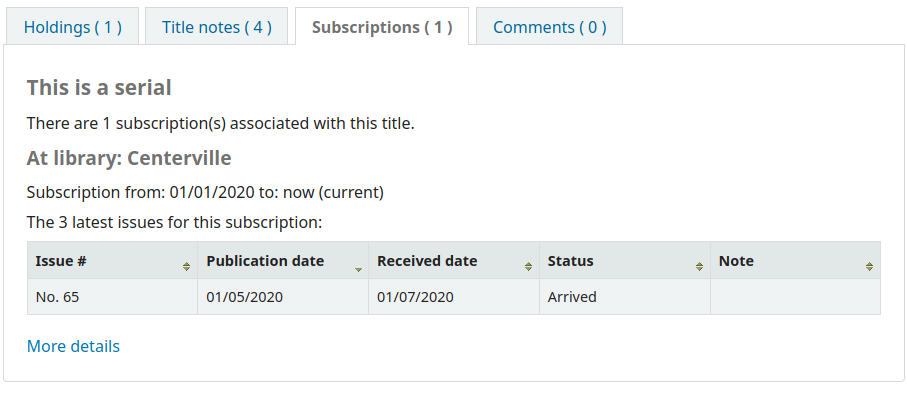
Note
You can customize the columns of this table in the “Table settings” section of the Administration module (table id: subscriptionst).
Si vous autorisez les commentaires, ils s’afficheront dans l’onglet suivant
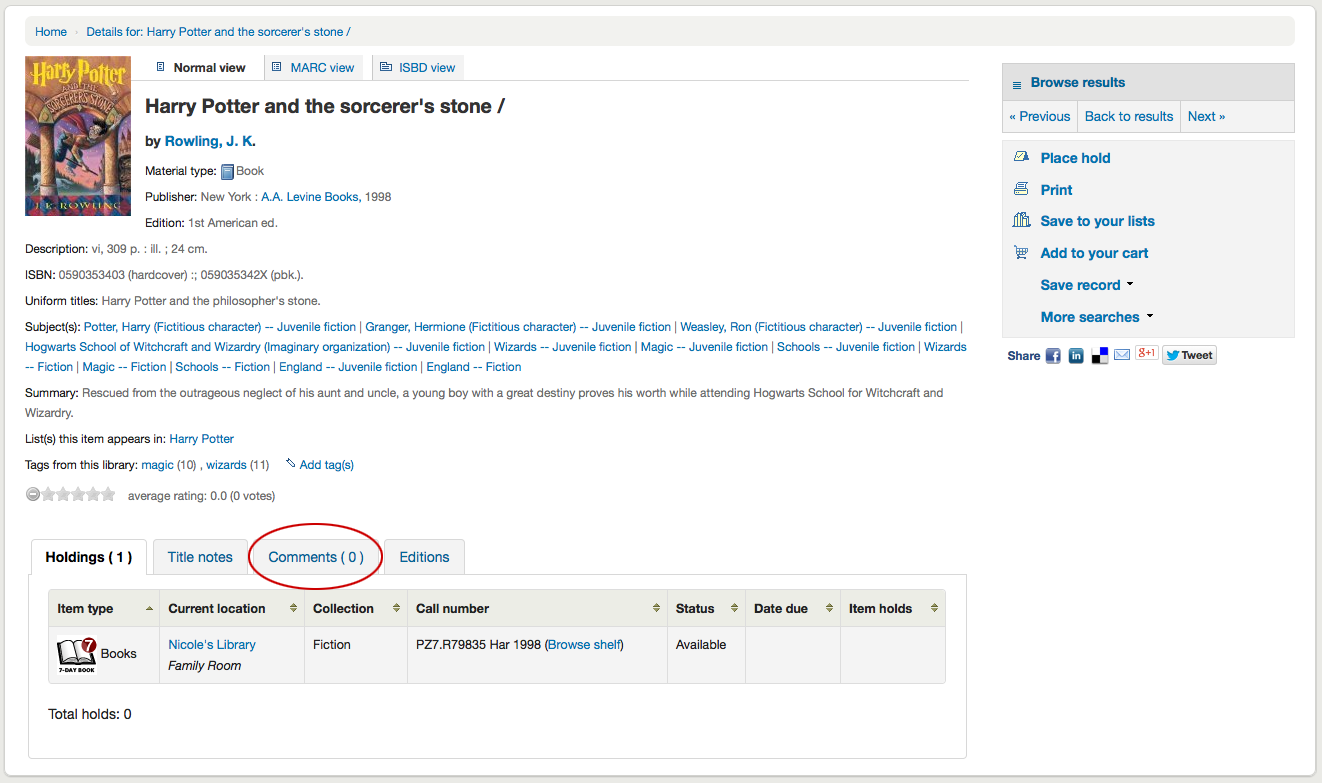
If the OPACAuthorIdentifiers system preference is turned on, and that your author authority records have standard identifiers, there will be an “Author identifiers” tab showing the identifiers with links to the author record on the source website.
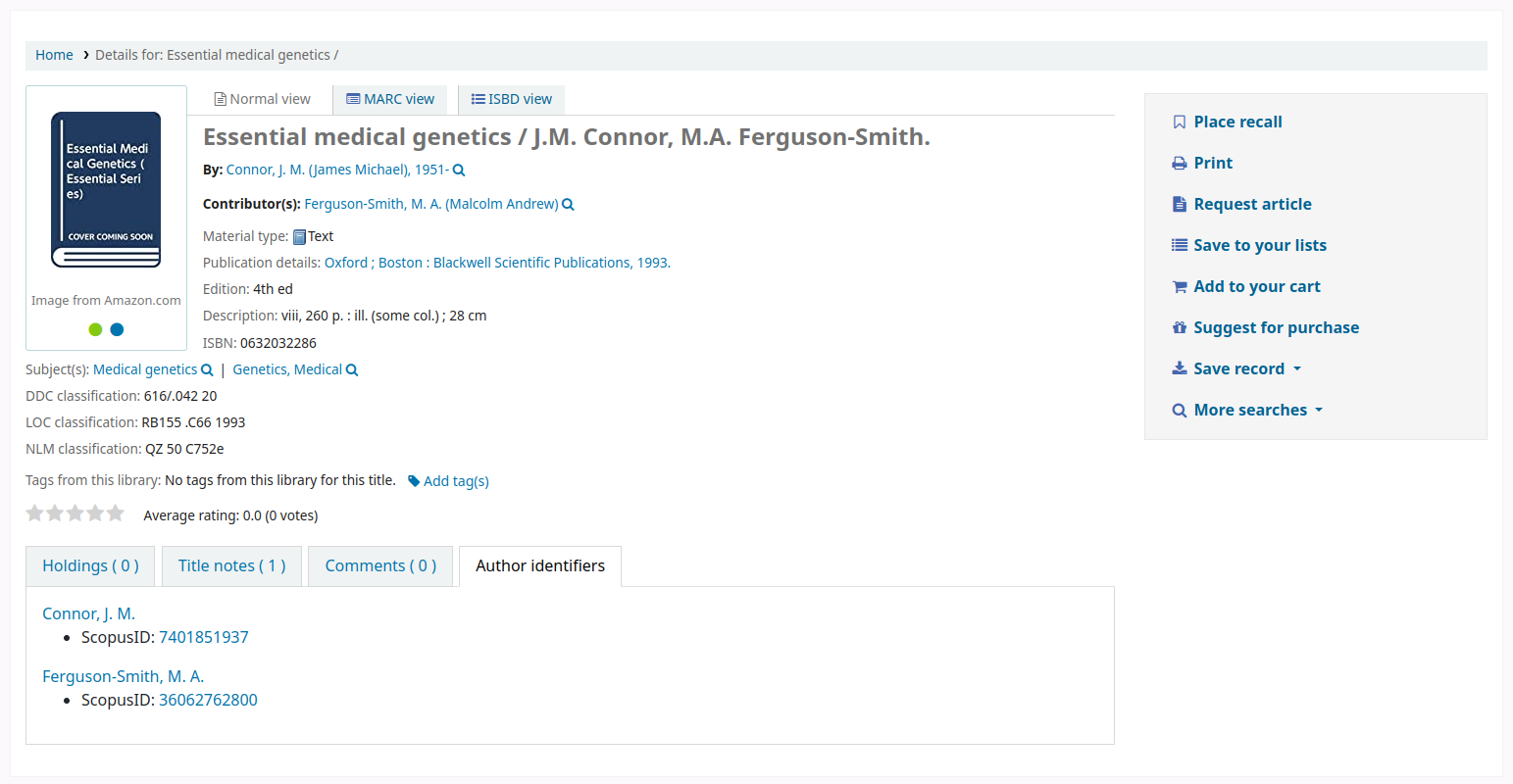
Enfin, si vous avez activé FRBR et que vous avez d’autres éditions du titre dans votre collection, vous les verrez dans l’onglet “Editions”.
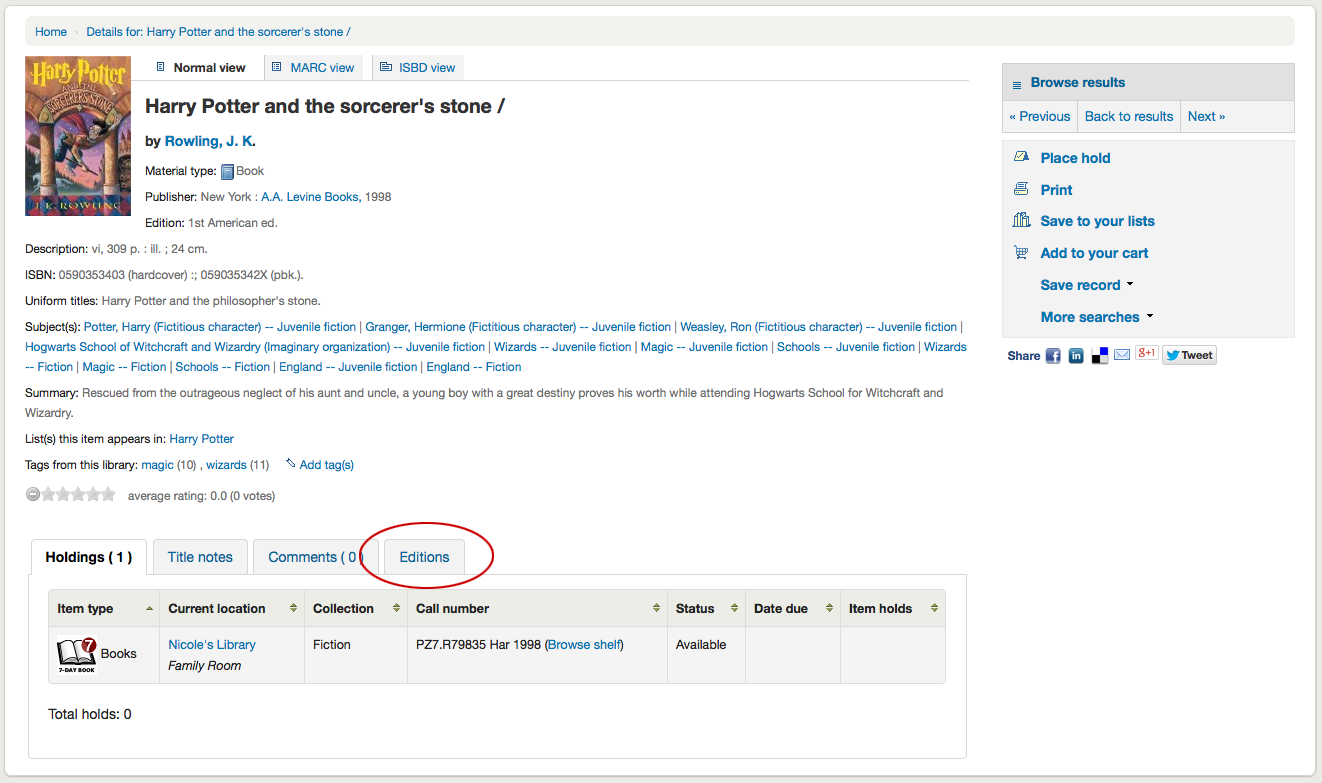
A droite des détails, vous trouverez une série de cases. La première case contient plusieurs boutons aidant à naviguer dans les résultats de recherche. Depuis ici, vous pouvez voir le prochain ou le précédent résultat de votre recherche ou revenir aux résultats.
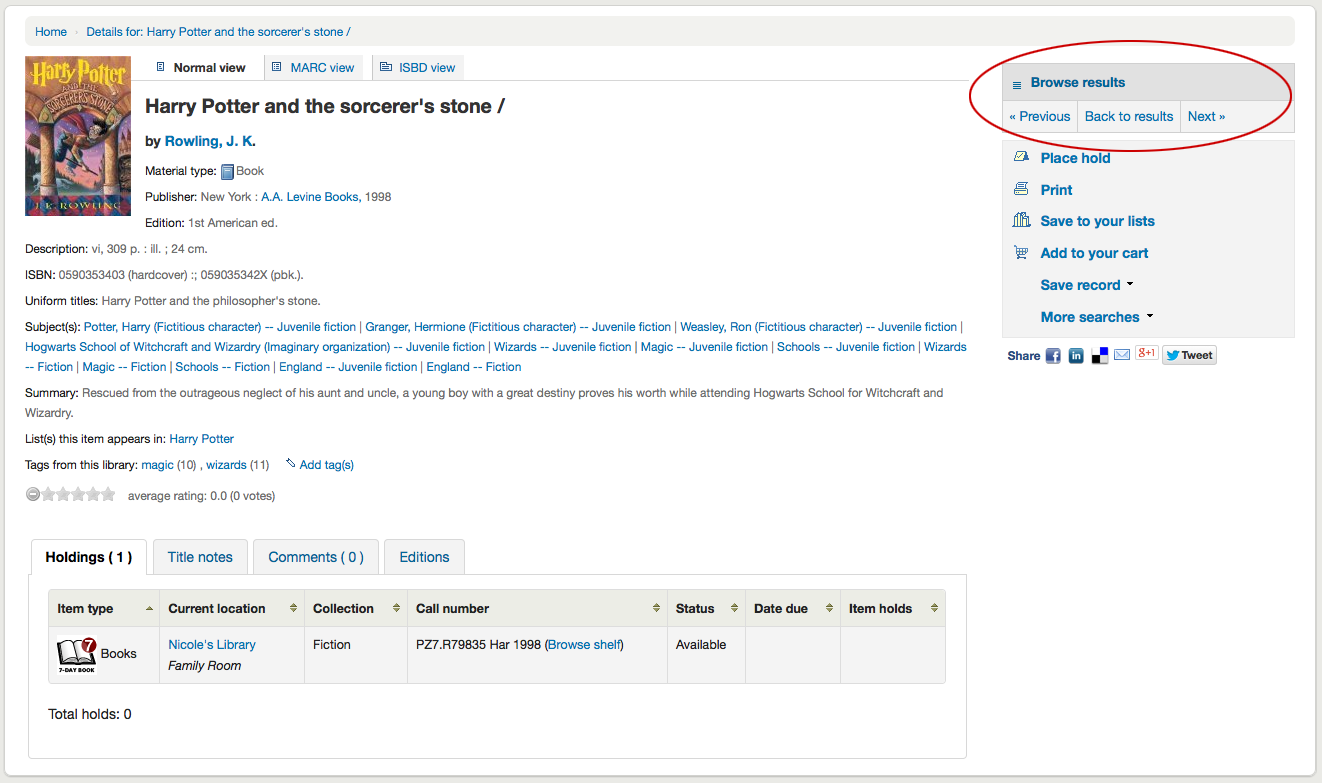
Clicking “Browse results” at the top of the right column will open up your search results on the detail page

Below the search buttons you’ll find the links to place a hold, print the record, save the record to your lists, add it to your cart or send to a device (using a QR code).
Another option that will appear on this right hand side bar, if a library is allowing purchase suggestions (see the suggestion system preference), is the ability to “Suggest for Purchase”. Clicking this link will bring the user to the purchase suggestion form to fill out.

Clicking “More searches” will show the list of libraries you entered in your OPACSearchForTitleIn preference
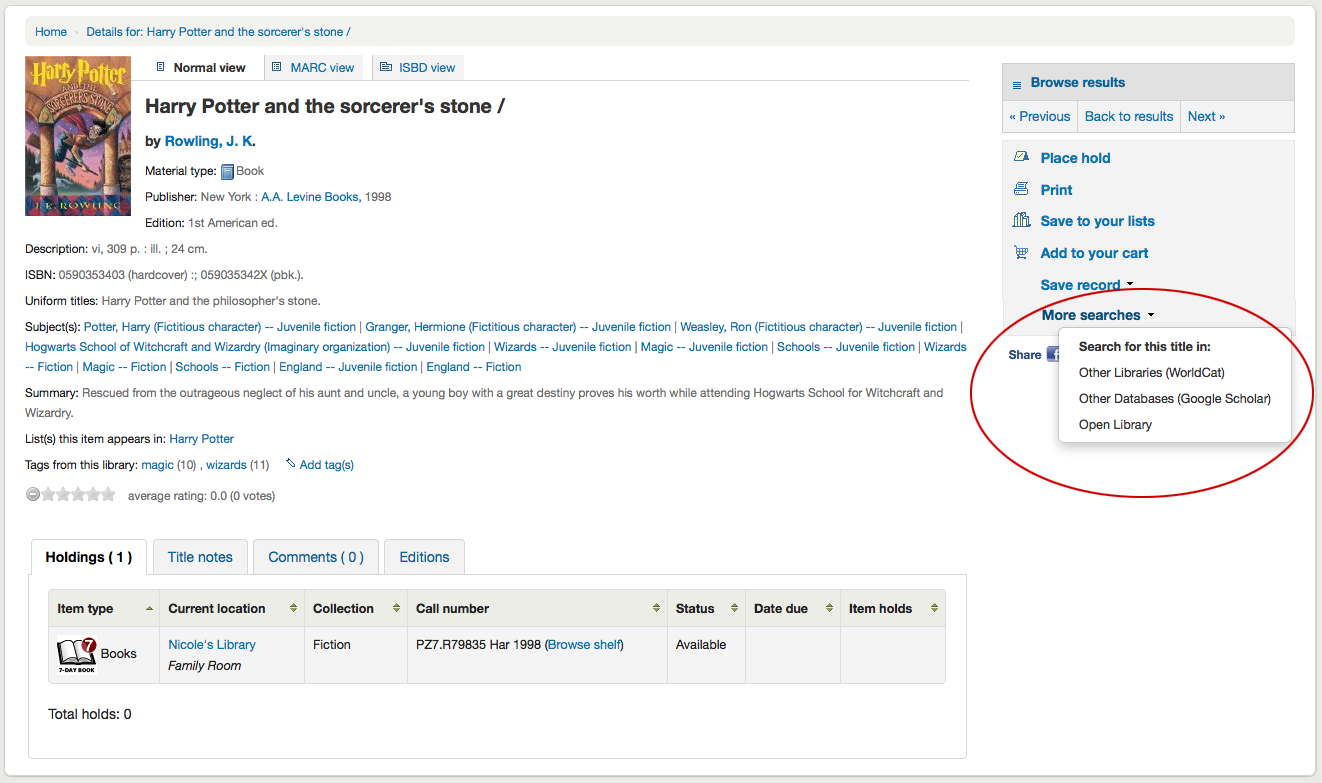
Under the “Save record” label you will find a series of file formats you can save the record as. This list can be customized by altering the OpacExportOptions system preference.

Il est possible d’activer jusqu’à trois modes d’affichage du détail bibliographique : “Normal”, MARC et ISBD. Pour cela, cliquez sur les onglets situés tout en haut de la notice
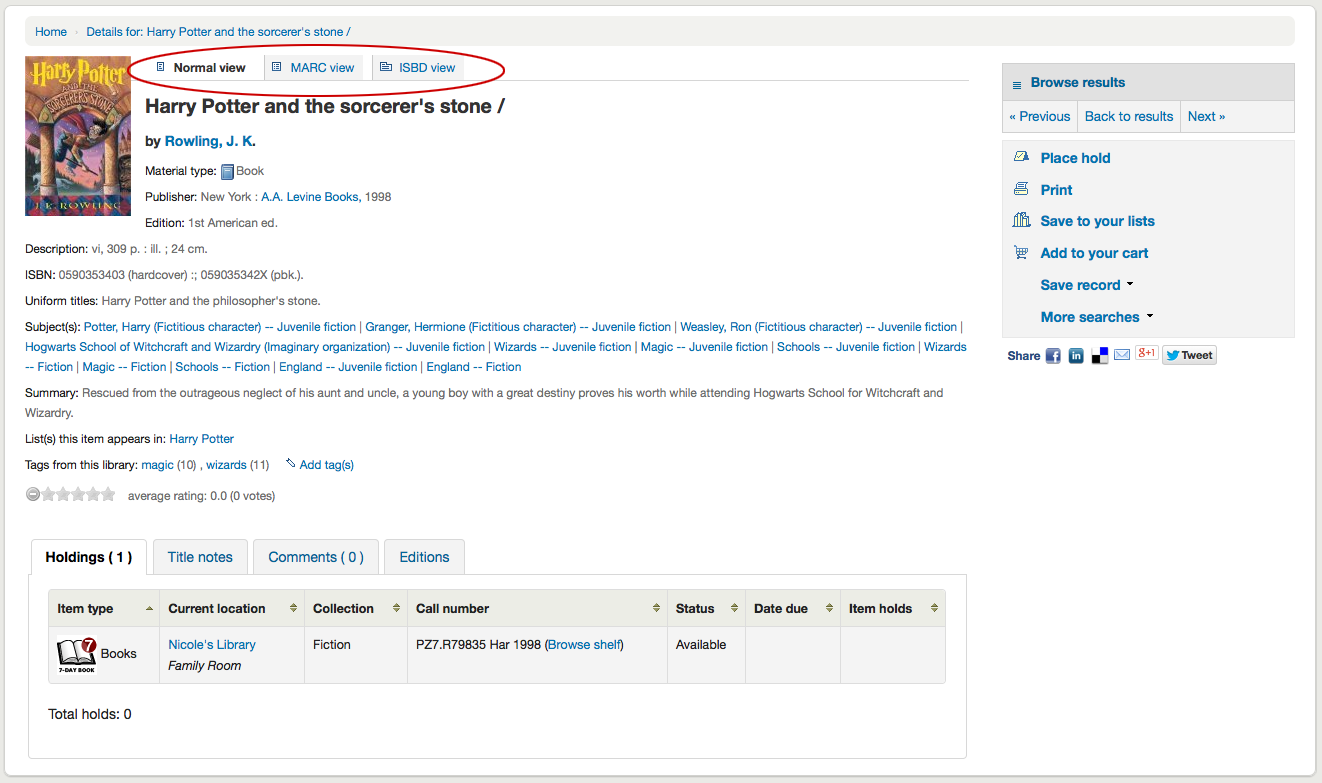
Lists and the cart
A cart is a temporary holding place for records you’re interested in finding during this session. That means that once you log out of the OPAC or close the browser you lose the items in your cart. A list is a more permanent location for saving items. To learn more about lists, check the Lists in the staff client chapter of this manual.
Listes
Patrons can manage their own private lists by visiting the “your lists” section of their account.
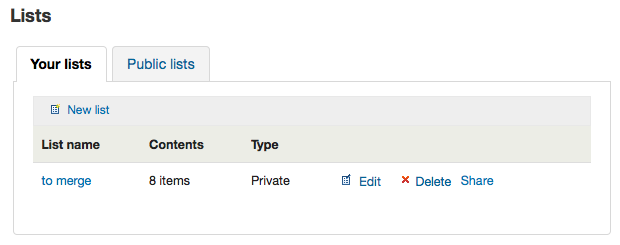
Creating lists
Lists can also be created by choosing the “New list” option in the “Add to” menu on the search results
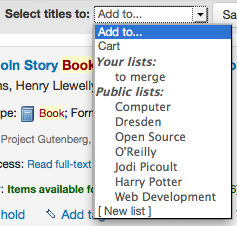
To create a list the patron simply needs to click the “New list” link and populate the form that appears
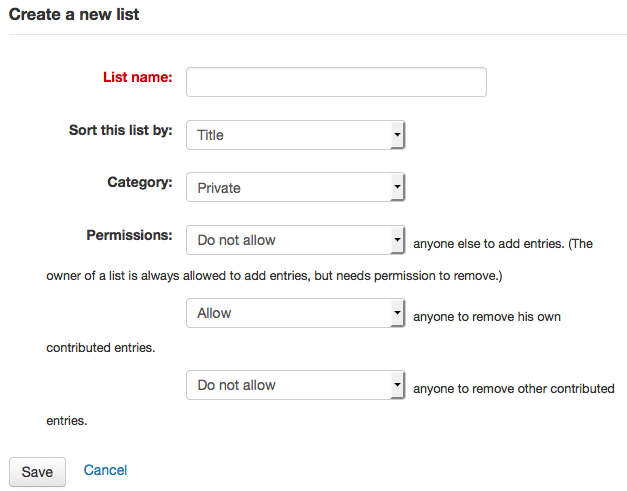
The only field required is the “List name,” but the patron can also choose how they want the list sorted and if the list is public or private.
A private list is managed by you and can be seen only by you (depending on your permissions settings below)
A public list can be seen by everybody, but managed only by you (depending on your permissions settings below)
Important
If you aren’t allowing patrons to create public lists with the OpacAllowPublicListCreation preference then patrons will only be able to create private lists.
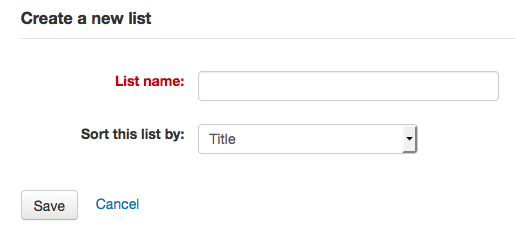
Pour finir, décidez quelles autorisations seront sur la liste. Vous pouvez autorisez ou interdire:
à une autre personne d’ajouter des entrées
à une autre personne de supprimer ses propres entrées
Note
Le propriétaire d’une liste est toujours autorisé à ajouter des entrées, mais il doit avoir les droits pour les retirer.
n’importe qui à supprimer d’autres entrées proposées.
Adding titles to lists
Les titres peuvent être ajoutés aux listes à partir des résultats de recherche et/ou de la notice bibliographique. Les options pour ajouter des documents à la liste, apparaissent sous chaque résultat et dans la partie supérieure de la page des résultats
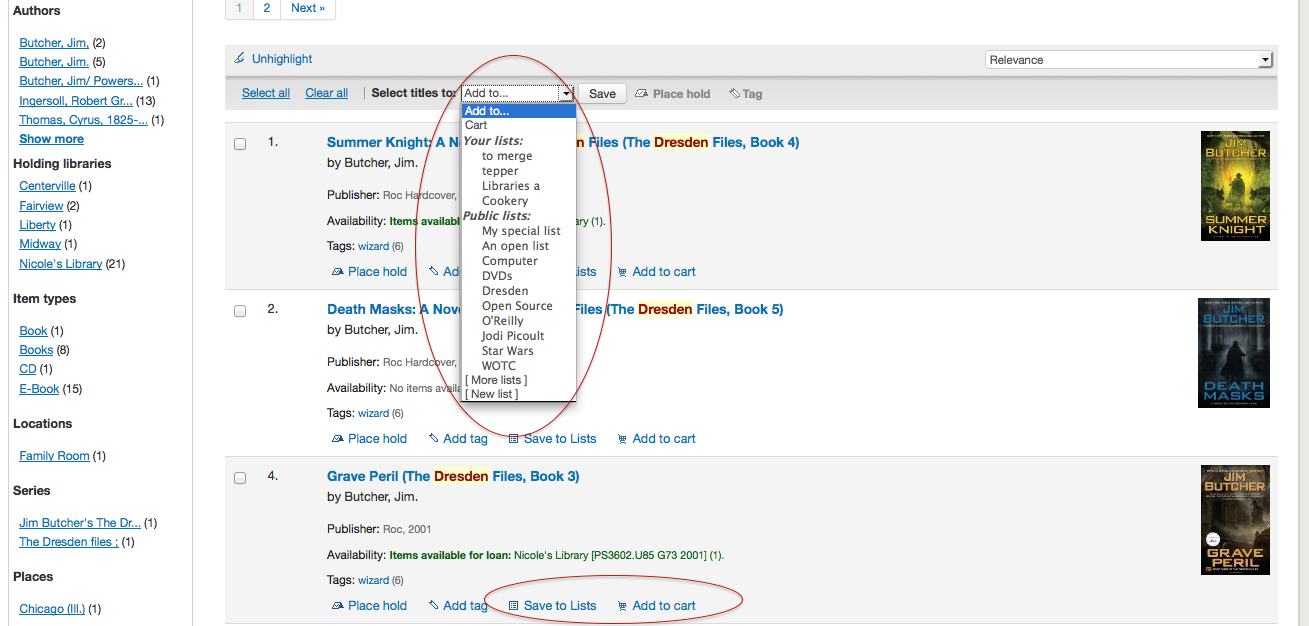
To add a single title to a list, click the “Save to lists” option and then choose the list you’d like to add the title to. To add multiple titles to a list check the boxes on the left of the titles you want to add and then choose the list you want to add the titles to from the “Add too” pull down at the top of the screen.
Viewing lists contents
To view the contents of a list, click on the list name under the “Lists” button.

Le contenu de la liste sera similaire aux pages de résultats de recherche sauf qu’il y aura différentes options situées en haut de la liste.
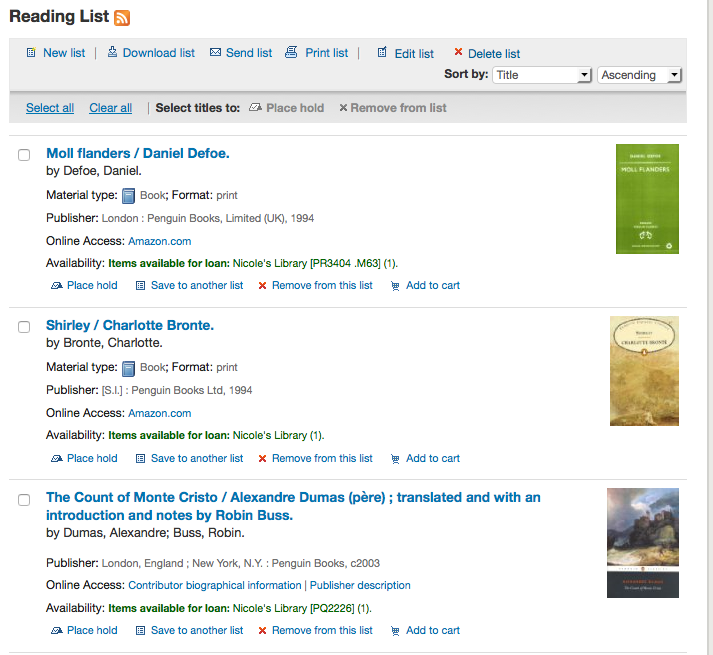
À la droite du titre de la liste, il y a une icône de fil RSS qui vous permettra de vous abonner aux mises à jour de la liste.
Si vous utilisez les options situées au-dessus de la liste, vous pouvez réserver plusieurs documents , télécharger le contenu de la liste, envoyer par e-mail la liste ou l’imprimer.
To place a hold on one or more list items check the box to the left of the item and click the “Place hold” link at the top
To download the list contents click the “Download list” link and choose the format you’d like to download the list in
To email the list contents to someone, click the “Send list” link and enter in your email details in the form that pops up
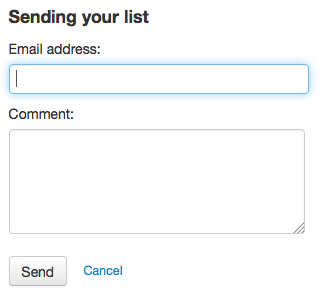
To print the contents of your list out click the “Print list” link
Managing lists
Once the list is saved patrons can begin adding items to it. From the “your lists” tab on the patron record the patron can edit and delete the lists they have created by clicking the appropriate link to the right of the list name.
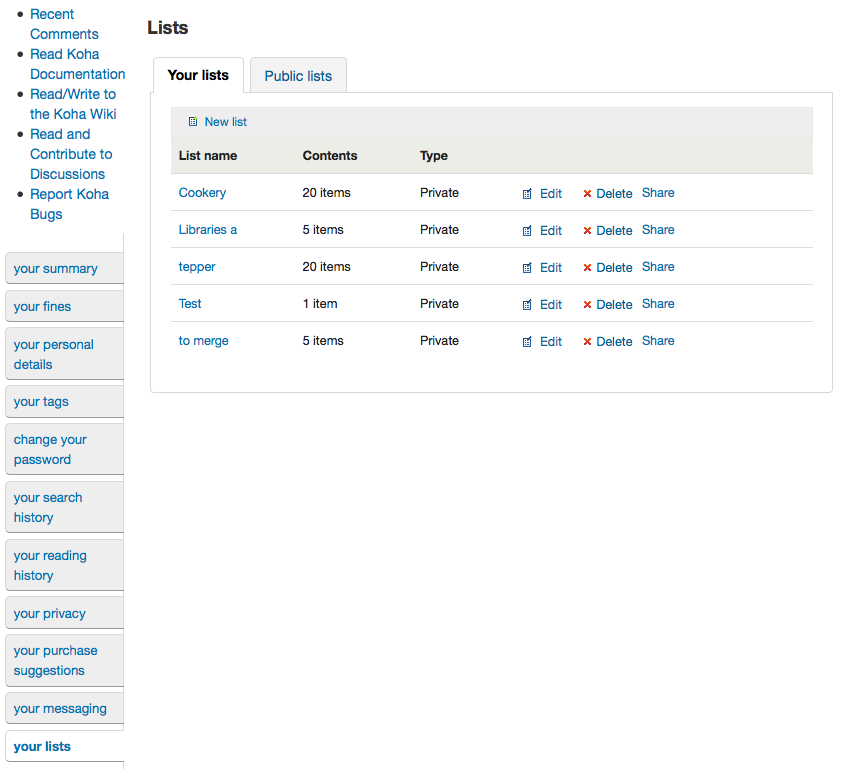
Pour modifier le titre des listes ou le tri des adhérents, cliquez sur le lien “Modifier”.
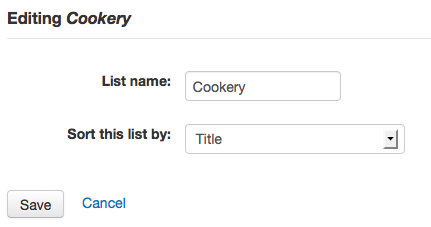
Lorsque vous cliquez sur “Supprimer” à côté d’une liste, il vous sera demandé de confirmer la suppression de la liste.
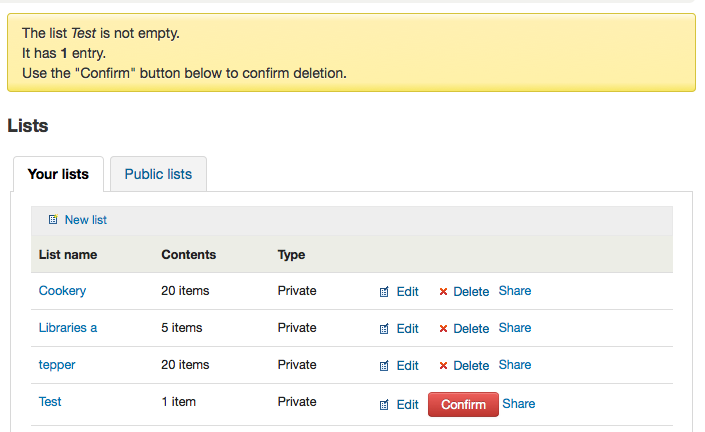
La liste ne sera pas supprimée tant que vous n’aurez pas cliqué sur le bouton “Confirmer” situé à droite de la liste que vous souhaitez supprimer.
If the library is allowing you to share private lists with the OpacAllowSharingPrivateLists preference then you will see the “Share” link on your list of lists and the “Share list” link at the top of each individual list. Clicking this will ask you to enter the email address of a patron.
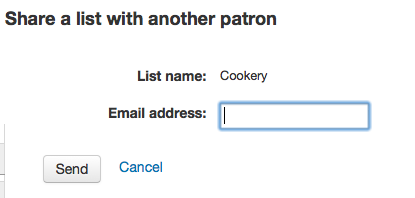
Une fois l’adresse e-mail saisie, un message de confirmation s’affichera

et un message sera envoyé à cet adhérent.
Panier
Adding titles to the cart
Vous pouvez ajouter des titres au panier à partir des résultats de recherche et/ou de la notice bibliographique. Les options pour ajouter des exemplaires au panier, apparaissent sous chaque résultat et en haut de la page

Clicking the “Add to cart” button will add the one title to your cart. To add multiple titles at once, check the box to the left of each result and then choose “Cart” from the “Add to” pull down at the top of the screen. Once titles are added to the cart you will be presented with a confirmation
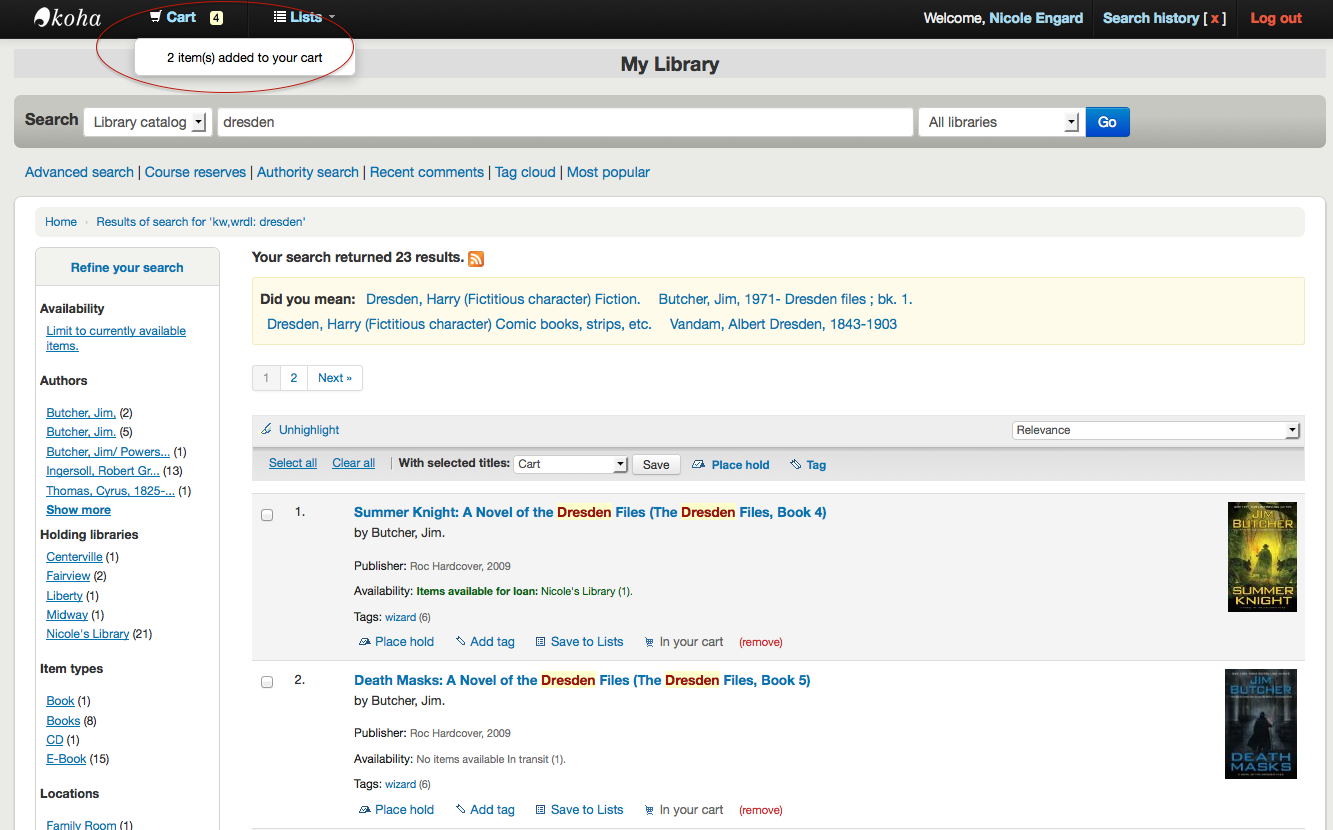
A partir des résultats, vous verrez les exemplaires qui sont déjàdans votre panier et vous pourrez supprimer ces exemplaires de votre panier en cliquant sur “Supprimer” (remove).

Managing the cart
Une fois tous les titres ajoutés dans votre panier, vous pouvez gérer le contenu en cliquant sur le bouton “Panier” situé en haut de l’écran. Votre panier s’ouvre dans une nouvelle fenêtre.
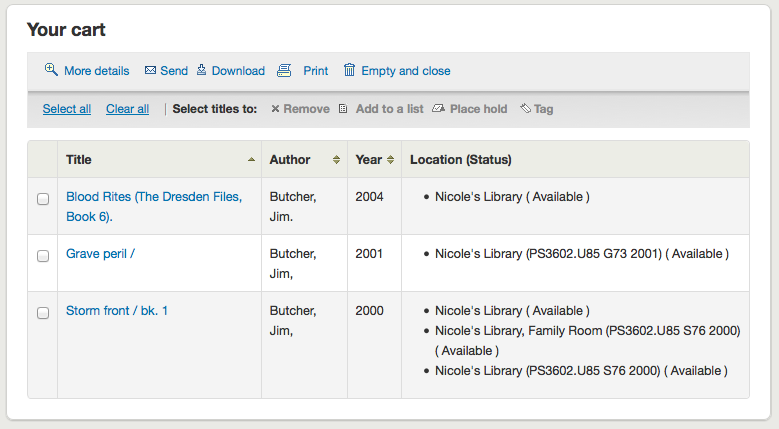
Il y a plusieurs boutons situés dans la partie supérieure du panier.
First is the “More details” button. Clicking this will show you additional information about the titles in your cart (ISBNs, subjects, publisher info, notes and more).

Next is the option to send the contents of your cart to an email address. This is handy if you want to send the resources you found at the library to your home email account to refer to later or to send to a patron researching a specific topic. Clicking this link will open up a new window that asks for the email address and message to send.
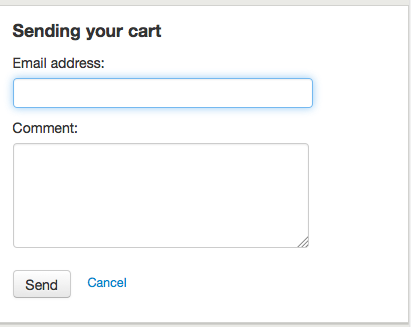
Important
Le contenu du panier peut être envoyé par e-mail uniquement par des utilisateurs connectés. De ce fait, cela évite que la fonction e-mail du panier soit utilisée pour spammer.
In addition to sending your cart you can download the contents of your cart in several pre-defined formats or using a CSV profile that you defined in the tools module.

Enfin, vous pouvez imprimer le contenu de votre panier en cliquant sur le lien “Imprimer”.
In addition to the various different ways to save the contents of your cart, there are ways to add value to the data in your cart. By selecting one or more titles from the cart you can add them to a list (click “Add to a list”), place hold(s) (click “Place hold”), or tag them (click “Tag”). All of these operations follow the same procedure as they do when performing them in the OPAC.
Placing holds
Patrons can place holds on items via the OPAC if they’re logged in and you have the OPACHoldRequests preference set to “Allow”. If the item can be placed on hold the option to place it on hold will appear in several different places.
When viewing a list or search results page you’ll see the option to place hold on multiple items by checking the boxes to the left of the results and clicking “Place hold” at the top

Sur une liste ou sur la page de résultats de recherche, le lien “Réserver” se situe en bas des informations du titre

Si vous consultez un titre individuel, vous verrez l’option pour réserver située dans le cadre sur le côté droit de l’écran

Peu importe à partir de quelles options vous réservez, vous serez amené sur le même écran de réservation.

Cochez la case à gauche des documents que vous souhaitez réserver
Le titre inclut un lien direct pour la page détaillée de la notice
La priorité indique la position de la réservation dans la liste d’attente
If allowed by your OPACAllowUserToChooseBranch preference the patron can choose where they’d like to pick up their hold. The list of available pickup locations will include all libraries that have “Pickup location” set to “Yes” on the library configuration page.
Si vous souhaitez voir plus d’options, cliquez sur “Afficher plus d’options”
Place hold form with more options
If you have the AllowHoldItemTypeSelection preference set to “Allow” and the record had more than one item type attached you will see an option to choose to limit the hold to a specific item type
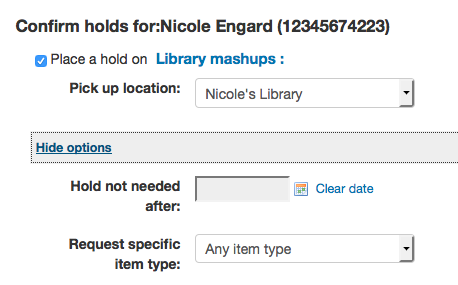
If allowed by your OPACAllowHoldDateInFuture preference, the “Hold starts on date” column will show. This field allows the patron to have their hold start on a future date.
By default holds placed in the system remain until canceled, but if the patron fills in a “Hold not needed after” date then the hold has an expiration date.
Important
Expired holds are removed by the expired holds cron job, this is not an automatic process and must be set up by your system administrator
If allowed by the OpacHoldNotes preference then patrons can leave notes about their holds for the library by clicking the “Edit notes” button
Image
If the EnableItemGroupHolds system preference is set to “Enable” and the record has item groups, the patron can choose to place a hold on the next available item of a group, rather than the next available item on the whole record or a specific item.
Depending on the rules you set regarding item specific holds in your circulation and fines rules the patron will be allowed to choose whether to place the hold on the next available copy and/or a specific copy.
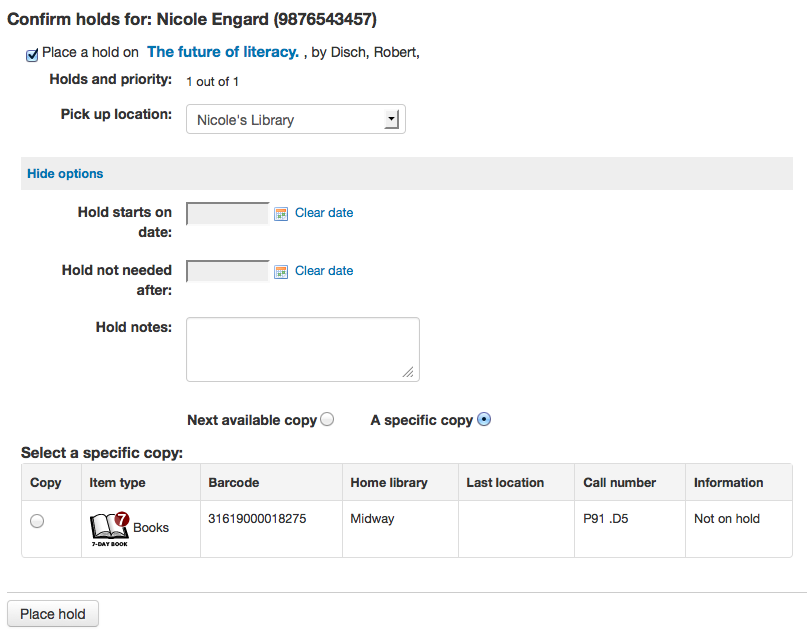
After clicking the “Place hold” button the patron will be brought to their account page where they’ll see all of the items they have on hold.
Requesting recalls
If your library accepts recalls (see setting up recalls for more information), patrons will be able to place recalls on items.
The option to request a recall appears in various places in the OPAC:
In the results list after a search, the “Place recall” option appears at the bottom of each recallable result.

In the detailed record. the “Place recall” option appears on the right side of the screen (or bottom in mobile view) in the options

Either of those links will lead to the recall form.
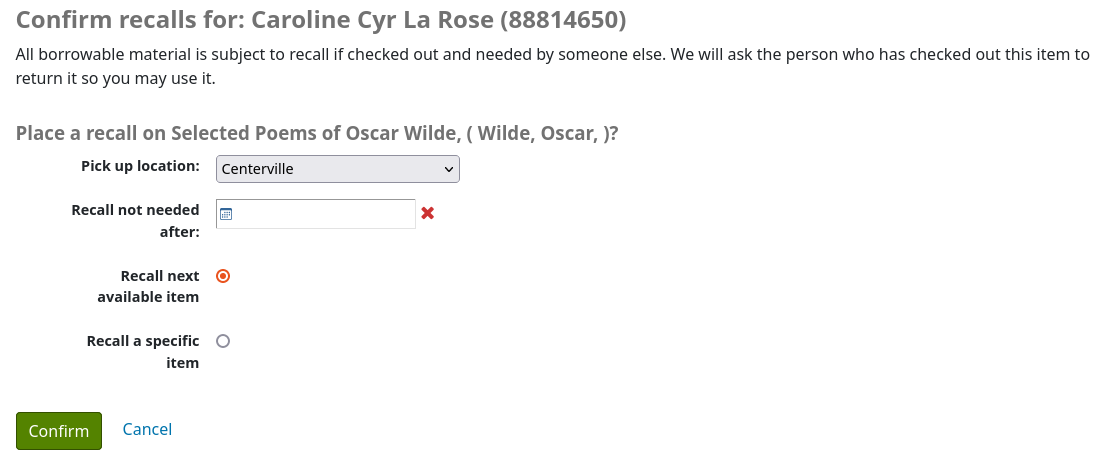
Pick up location: the patron can choose where they’d like to pick up their recalled item.
Recall not needed after: if the patron not need this item after a certain date, they can enter it here. The recall will be automatically expired (with the expire_recalls.pl cronjob) after that date.
Recall next available item or Recall a specific item: the patron can choose to recall any item or a specific one. If they choose “Recall a specific item”, they will be asked to select the item in the list.
Once the patron confirms their recall request, they will have get a message saying the the patron who currently has the item will be notified. The request will be added to the recalls tab in their account summary, as well as in their recall history list.
Enhanced content
Taguer (mots-clés)
Depending on your settings for the TagsEnabled, TagsInputOnList and TagsInputOnDetail preferences you may be able to add tags to bibliographic records from the search results and/or bibliographic records. If you are allowing patrons to add tags from the search results screen you will see an input box below each result and a “Tag” option at the top of the screen.

Pour ajouter un tag à un titre, saisissez les tags (mots-clés) (séparés par des virgules) dans la barre de saisie “Nouveau tag”, et cliquez sur “Ajouter”. Un message de confirmation s’affichera.
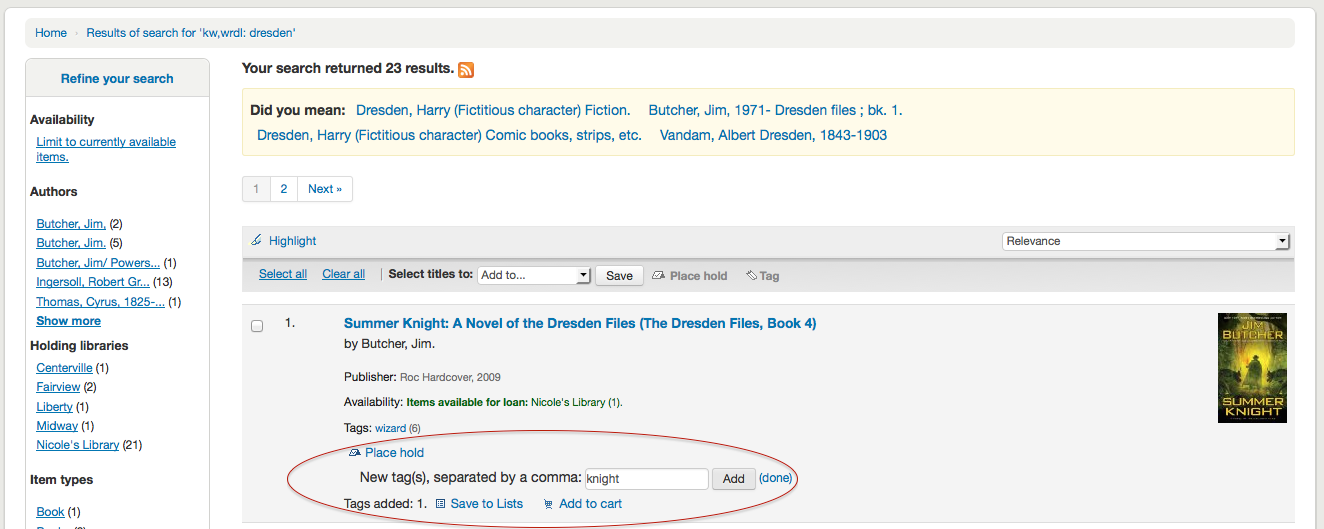
A partir des résultats, il est possible de taguer des titres par groupe en cochant les cases sur la gauche et en cliquant sur le bouton “Tag”. Une barre de saisie apparaîtra pour que vous ajoutiez des tags à tous les titres que vous avez sélectionnés.
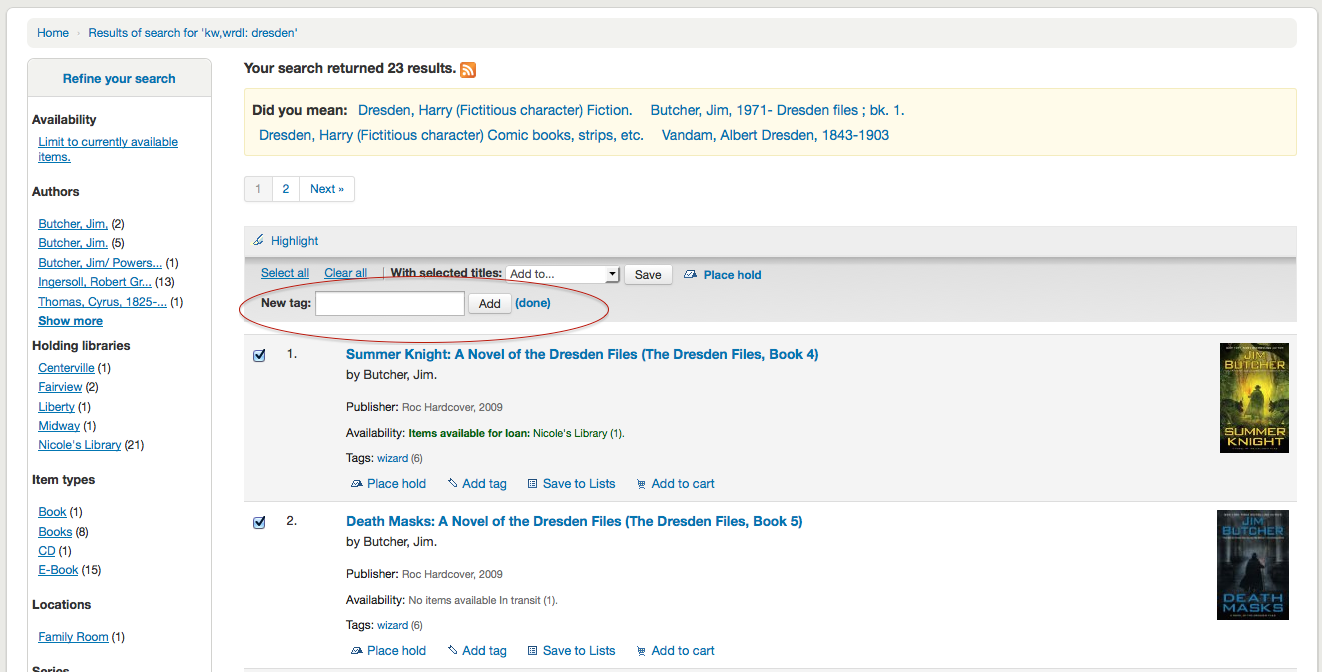
Emojis can also be included using the emoji picker when adding tags

Zotero
Zotero is a Firefox add on that allows for the saving and generating of a bibliography. Learn more about and download Zotero at http://zotero.org.
A partir des résultats à l’OPAC, si Zotero est installé, vous verrez un icône sous forme de dossier dans la barre d’adresse à droite de l’URL. Cliquez sur le dossier afin de remonter la liste des titres de la recherche et de les ajouter à Zotero.
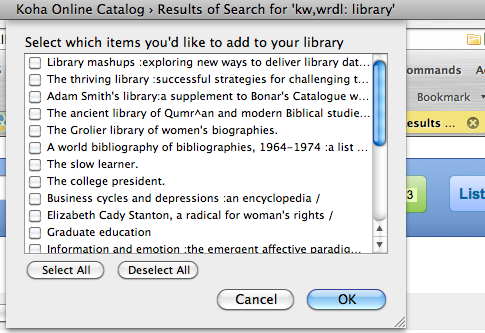
Sélectionnez les titres que voulez ajouter à Zotero et cliquez sur le bouton “OK”. Vous pourrez voir les titres ajoutés dans votre bibliothèque Zotero.

Custom RSS feeds
Using the RSS feeds cron job you can generate an RSS feed for any SQL query (for example a new acquisitions RSS feed). The cron job is run on the command line to produce an RSS XML document.
Le résultat pourra être classé dans un répertoire accessible depuis OPAC (ou l’intranet) afin que les utilisateurs puissent télécharger le flux RSS.
Un exemple d’utilisation peut être trouvé à: misc/cronjobs/rss.pl lastAcquired.conf
Normally the RSS cron job should be run periodically (e.g., daily) to keep the feed up-to-date.
Les listes du fichier de configuration (par exemple lastAcquired.conf) inclut:
nom du fichier modèle à utiliser
chemin du fichier exporté
Requête SQL
The RSS cron job runs the SQL query, then feeds the output of the query through the template to produce the output file.
Important
To use custom RSS feeds you need to turn on the RSS cron job.
OPAC self registration
If you allow it, patrons can register for their own accounts via the OPAC. If you have the PatronSelfRegistration preference set to “Allow” then patrons will see a link to register below the log in box on the right of the main OPAC page.
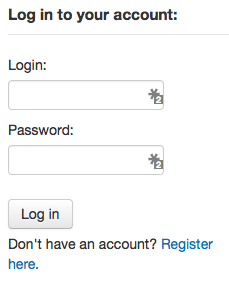
When the patron clicks the “Register here” link they will be brought to a registration page. The options on the registration page can be controlled by editing the PatronSelfRegistrationBorrowerMandatoryField and the PatronSelfRegistrationBorrowerUnwantedField preferences.

Once the patron has confirmed submitted their registration they will either be sent an email to confirm their account (if you have the PatronSelfRegistrationVerifyByEmail preference to require this) or presented with their new username and password. If the PatronSelfRegistrationPrefillForm system preference is set to “Show and prefill”, they will be presented with the prefilled login form.

Les adhérents qui s’inscrivent de cette façon n’auront pas de numéro de carte jusqu’à ce que la bibliothèque leur en assigne un, mais ils auront accès immédiatement à l’OPAC. Pour cette raison, il est conseillé de:
set up a provisional patron category for self registered patrons (such as “Self Registered) instead of using an existing patron category and set that value in the PatronSelfRegistrationDefaultCategory preference
give this patron category minimal circulation privileges in the circulation and fines rules (such as allowing a couple holds, but no check outs)
Les adhérents peuvent soit se présenter à la bibliothèque pour une vérification de leur identité avant de recevoir un numéro de carte qui leur permettra d’emprunter des documents; soit la bibliothèque conçoit des numéros de cartes à partir des règles internes, et les fournit aux adhérents auto-inscrits. La bibliothèque peut alors changer la catégorie d’adhérent en une plus appropriée (adulte, résident, non-résident, étudiant etc…) et ajouter un numéro de carte/code à barres.
Your account
If the opacuserlogin system preference is set to “Allow”, patrons can log in and access their account.
Once logged in patrons are brought to their account summary.
If patrons access the home page while logged in, and OPACUserSummary is set to “Show”, they will see a small summary of their account instead of the login fields.

From any page on the OPAC, clicking on their name at the top right of the page will bring a patron back to their account.
Réinitialiser votre mot de passe
If you have the OpacResetPassword system preference set to “Allow”, patrons can reset their password by clicking the “Forgot your password?” link found under the login box.
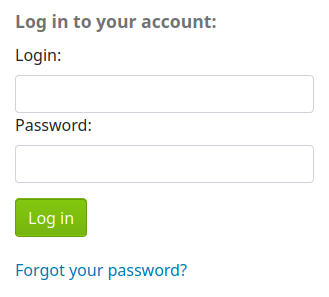
Once clicked, they will be presented with a form asking for their username and their email address.
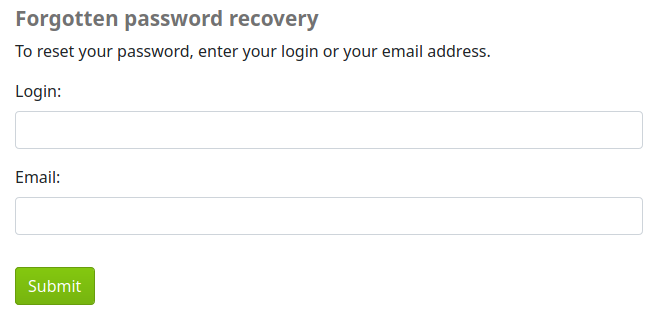
Avertissement
Patrons must have an email address on file to reset their password. If they don’t have an email address already in their file, they will get an error message

The system will then email the patron instructions for resetting their password.

The content of the email can be customized with the Notices and slips tool. The code of the letter is PASSWORD_RESET.
Your summary
From the “your summary” tab, patrons will see all of the items they have checked out with the overdue items highlighted in red.
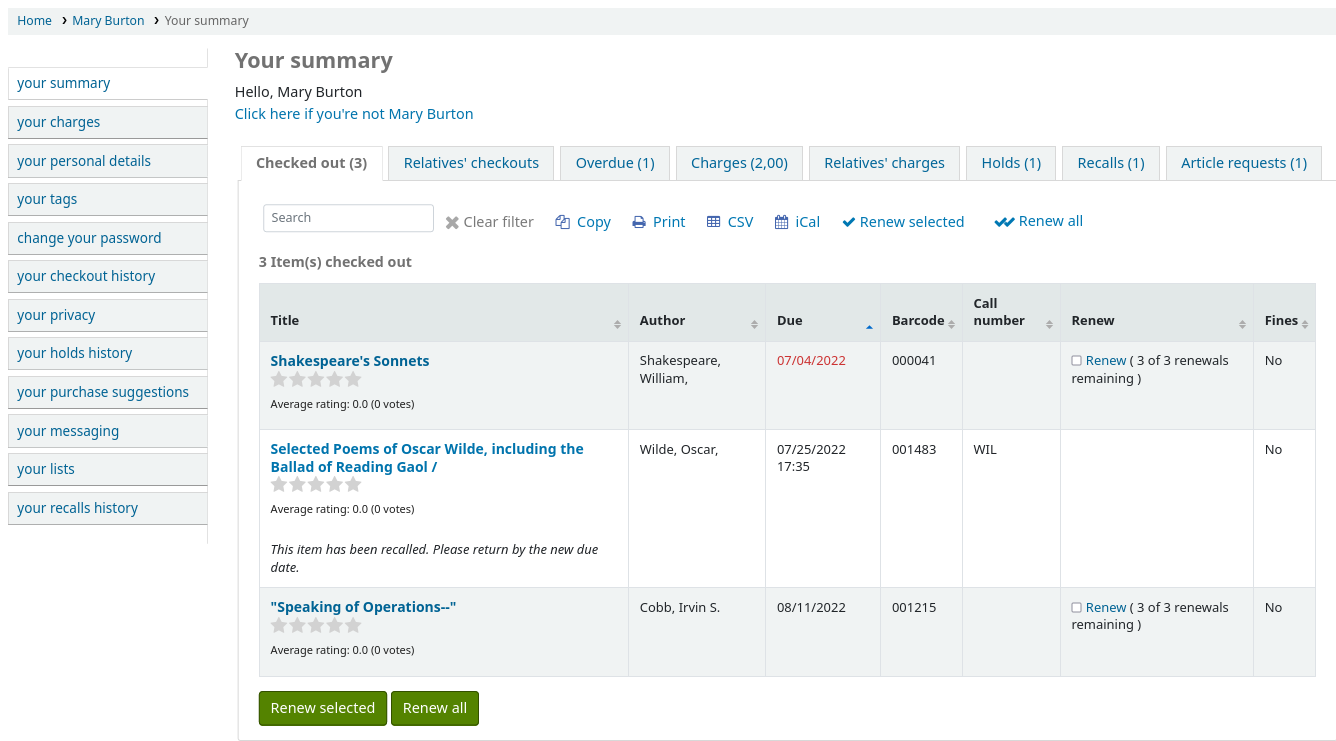
If OpacRenewalAllowed set to “Allow”, patrons will be able to renew their checkouts from the OPAC.
If the patron has pending charges exceeding the value set in OPACFineNoRenewals, a note will display explaining that renewals cannot be made.

A note will display if the patron cannot place holds due to their charges exceeding the value set in the maxoutstanding system preference.

If AllowPatronToControlAutoRenewal is set to “Allow patrons”, patrons will be able to choose whether or not they want their checkouts to be renewed automatically. If they choose ‘Yes’, items for which automatic renewal is enabled in the circulation rules will renew as expected. If they choose ‘No’, the automatic renewals that would have applied to this patron’s checkouts will not take place.

If you have HTML entered in the OPACMySummaryHTML preference then you will see that to the right of the “Fines” column.
If your patrons would like to see the items barcodes on their list of checked out items you can set up a patron attribute with the value of SHOW_BCODE and authorized value of YES_NO.
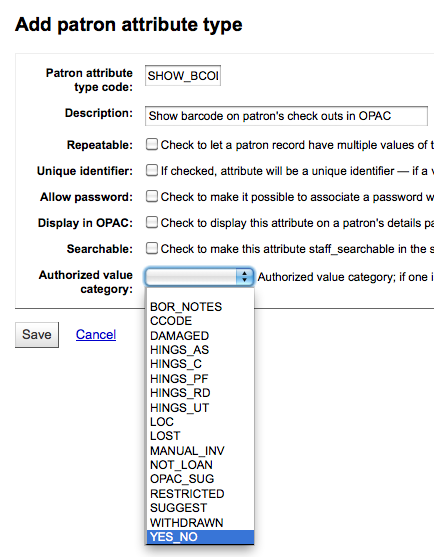
Puis, sur le compte de l’adhérent définir la valeur pour SHOW_BCODE sur YES.
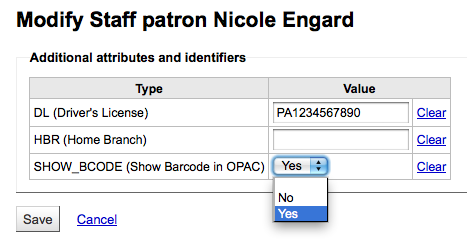
Cela ajoutera une colonne au tableau de résumé de l’OPAC qui affichera les code à barres des documents empruntés.
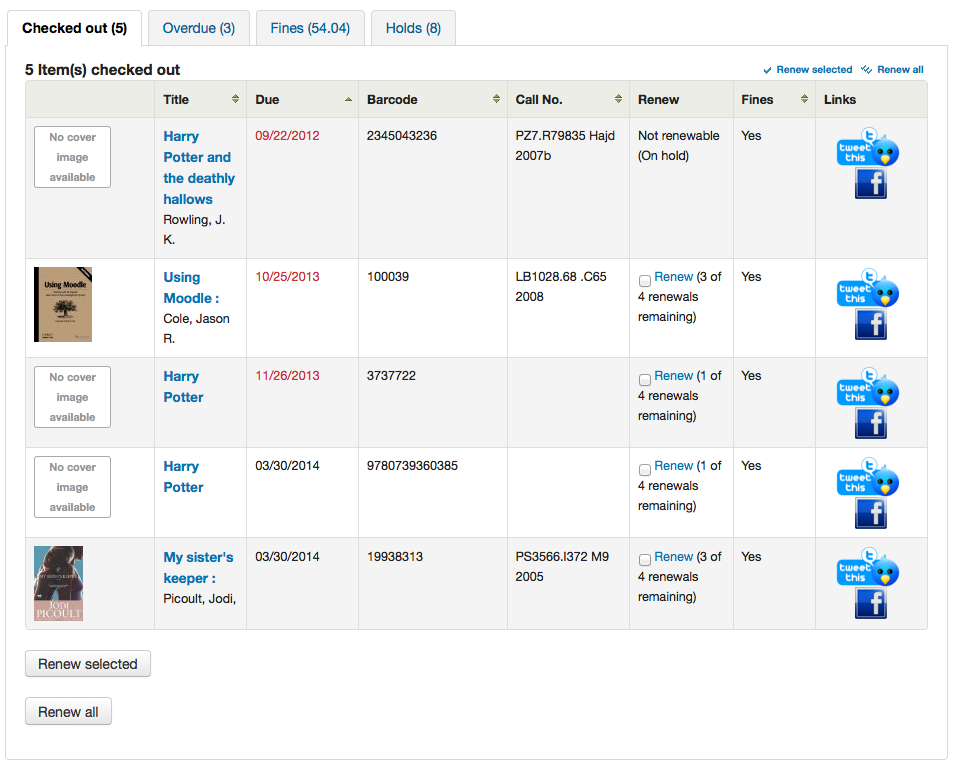
If you would like your patrons to leave a note on an item they have checked out allowcheckoutnotes preference must be set to allow.
In the patron’s summary of checkouts, there will be an added column to allow the patron to leave a note (for example: missing first page, or DVD is scratched). This note once confirmed by the patron will appear to the staff at the bottom of the staff interface’s home page, and also when the item is checked in.
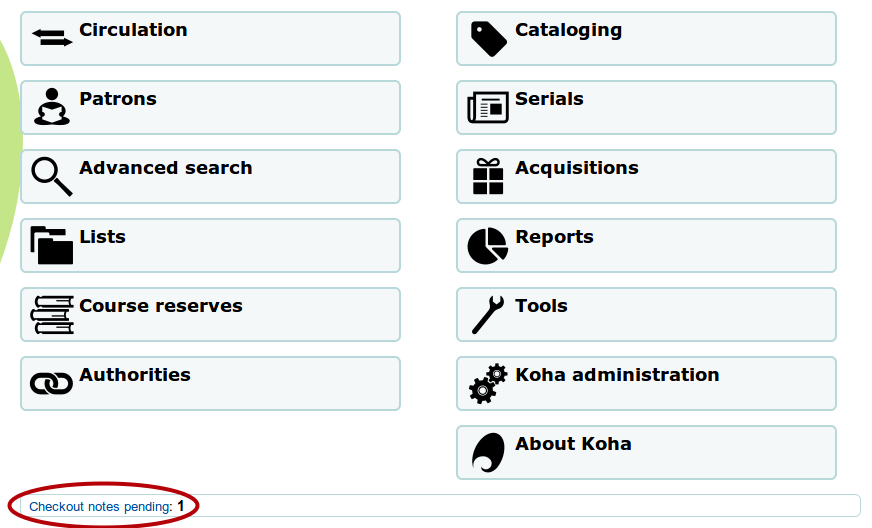
If their guarantee has allowed it via their privacy, or alternatively, if the staff is allowed to change this privacy setting in the staff interface with the AllowStaffToSetCheckoutsVisibilityForGuarantor system preference and this setting is turned on, when the guarantor logs in they will see a tab labeled « Relatives” checkouts » on their summary tab.

Si vous cliquez sur l’onglet “Retards”, cela affichera tous les documents en retard.
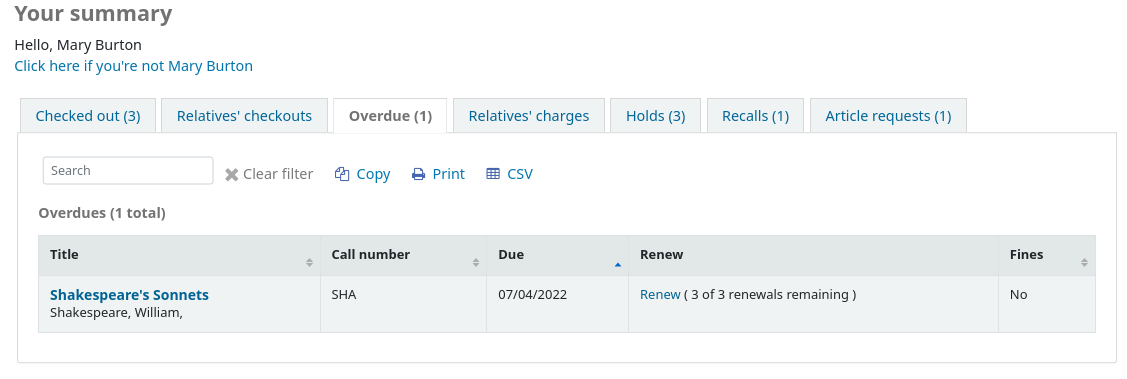
The “Fines” tab will show just a total of what the patron owes. Clicking on the total will take them to the “your fines” tab where they will see a complete breakdown of their fines and bills. If you don’t charge fines at your library you can turn the display of these tabs off by setting the OPACFinesTab preference to “Don’t allow.”

If their guarantee has allowed it via their privacy, or alternatively, if the staff is allowed to change this privacy setting in the staff interface with the AllowStaffToSetFinesVisibilityForGuarantor system preference and this setting is turned on, when the guarantor logs in they will see a tab labeled « Relatives” charges » on their summary tab.

The “Holds” tab shows the patron the status of all of the items they have on hold.
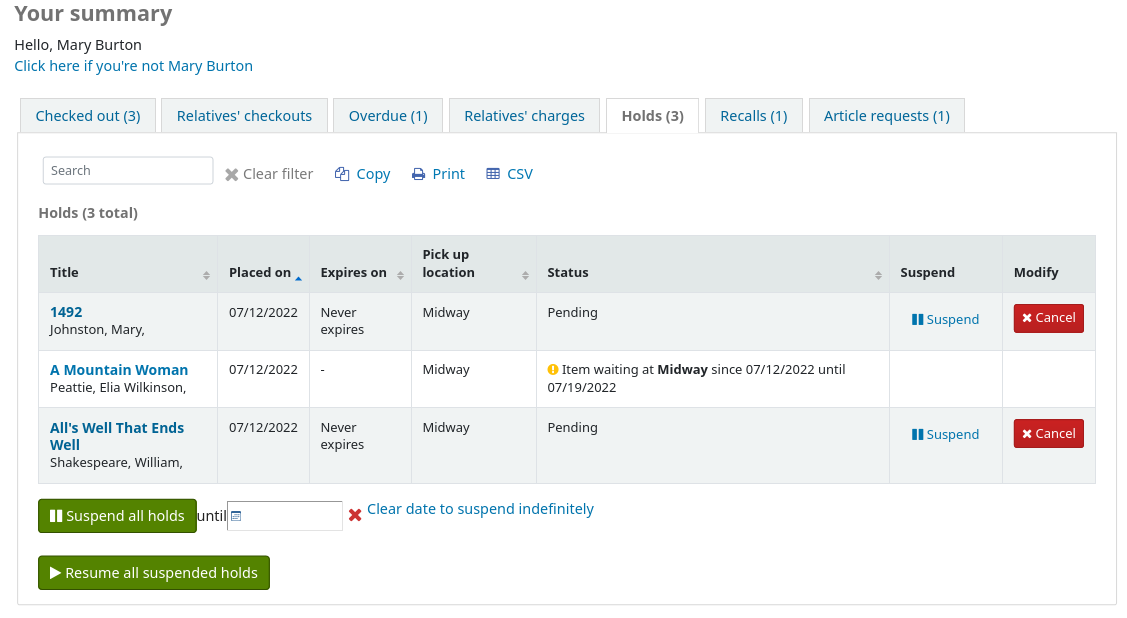
Patrons can cancel or suspend (depending on the value of your SuspendHoldsOpac system preference) their own holds if they are not in transit or already waiting for them. When they click “Suspend” they will be presented with the option to choose a date for their hold to resume.
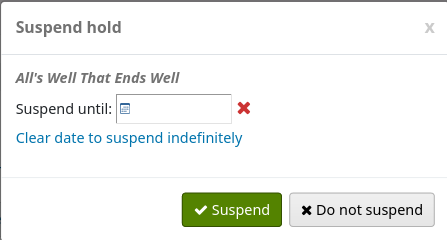
Ils peuvent également suspendre toutes leurs réservations pour une période non définie ou jusqu’à une date précise, s’ils remplissent les options de suspension situées en bas de la page.
Note
If you have your AutoResumeSuspendedHolds preference set to « Don’t allow » then you will not have the option to put an end date on the hold suspension
If your library allows recalls, the patron can see the recalls they have requested and their various statuses in the “Recalls” tab.
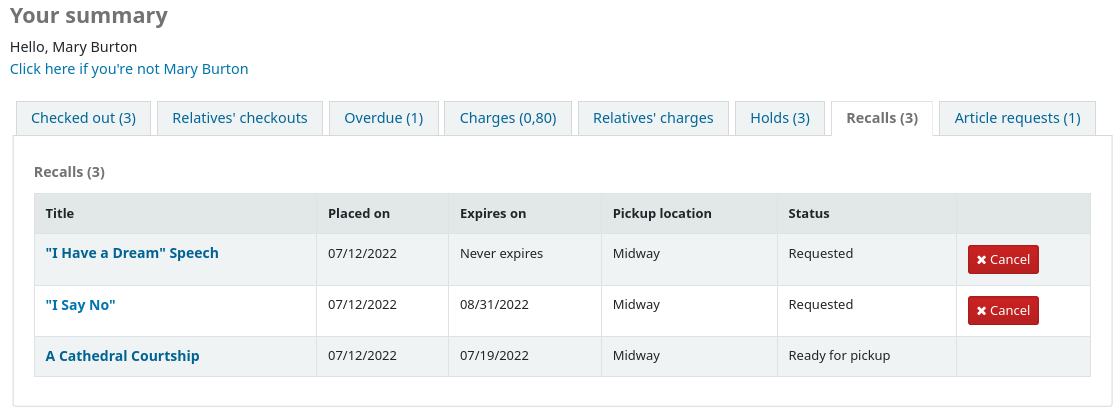
The patron can cancel a recall by clicking the “Cancel” button, provided that it is not already awaiting pickup.
Patron flags
Si vous avez activé un piège sur le compte adhérent, ils pourront voir l’un des messages d’erreur suivant en haut de page de leur compte.
Carte perdue

Changement d’adresse de l’adhérent

Note
this error message will not include a link to the update form if you have OPACPatronDetails set to “Don’t allow”
Adhérent suspendu

Your fines
If your library charges fines the next tab on the left is “your fines”. Opening this tab will show the patron an entire history of their accounting at the library.
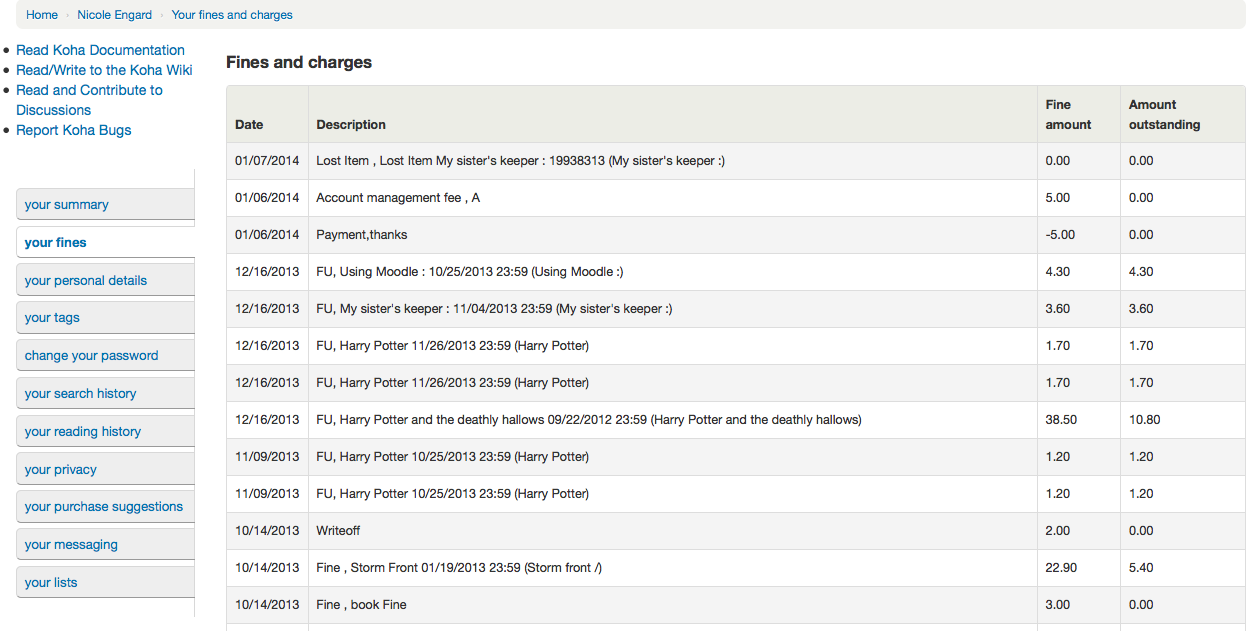
If you are allowing patrons to pay their fines using PayPal with the EnablePayPalOpacPayments preference there will be checkboxes to the left of each fine with an outstanding amount.
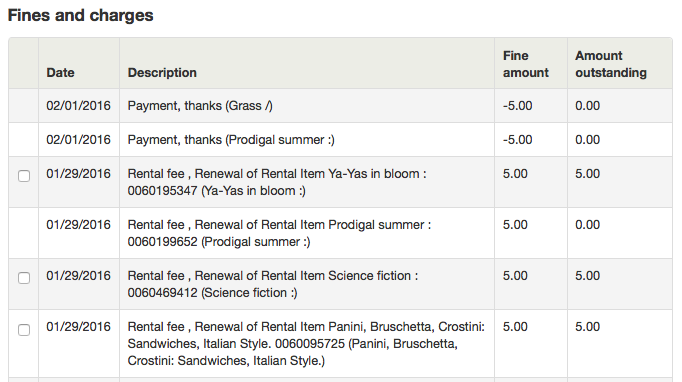
Au bas de l’écran, l’usager pourra voir l’option de payer avec PayPal pour les amendes qu’il aura sélectionnées.
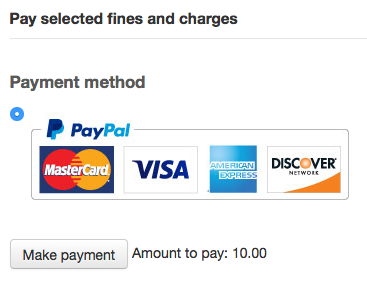
After paying they will be presented with a confirmation
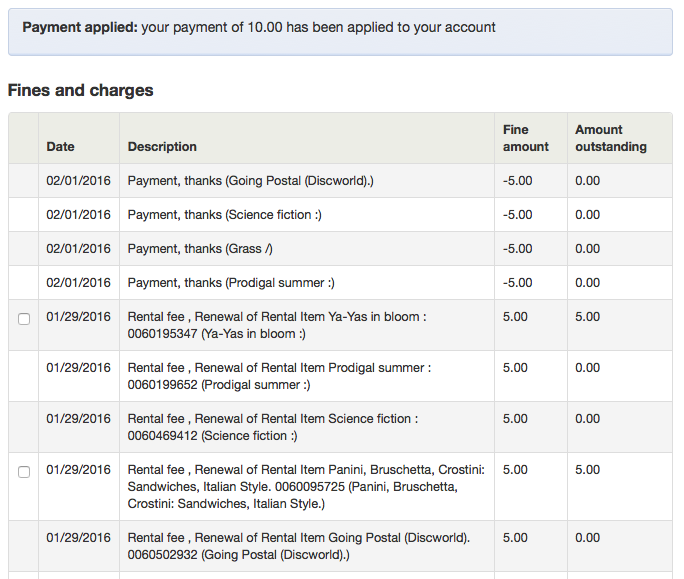
And you will see that the fine was paid using PayPal on the staff side.
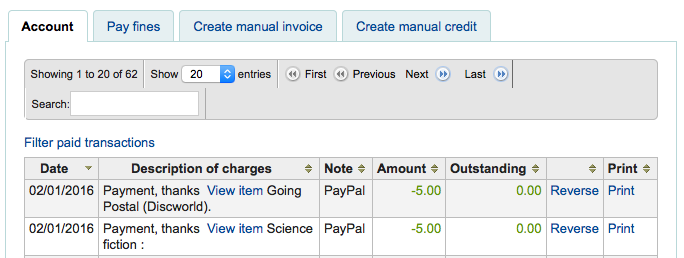
Your personal details
If you have your OPACPatronDetails preference set to “Allow”, your patrons will see a form filled in with their contacting information by clicking on the “Your personal details” tab. You can control what fields patrons see and can modify via the OPAC by setting the PatronSelfModificationBorrowerUnwantedField and PatronSelfModificationMandatoryField preferences.
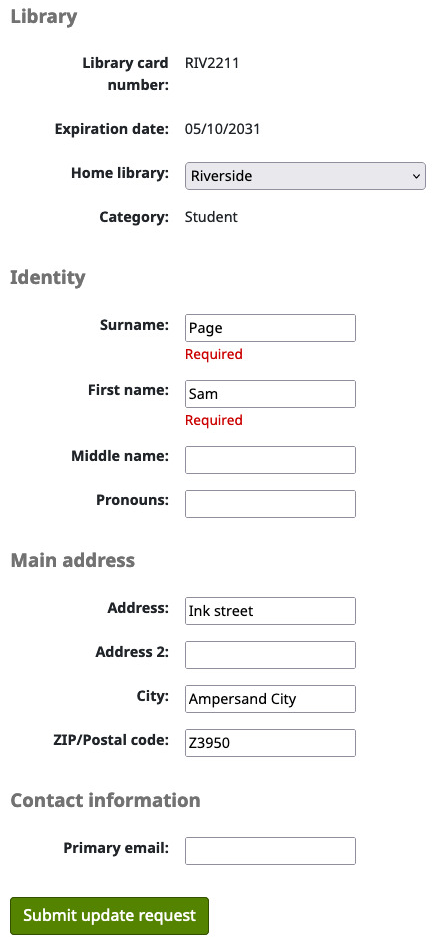
Patrons can edit their details in this form and click “Submit changes” to have their edits sent to the library for review before their record is updated. Staff will see all patrons requesting modification to their record listed below the modules on the main dashboard along with anything else awaiting library attention.

If the OPACPatronDetails preference is set to “Don’t allow” then patrons will simply see their details and a message stating that they should contact the library for changes.
Change your password
Next, if you have OpacPasswordChange set to “Allow” the next tab will be “change your password,” where patrons can change their password for logging into the OPAC. Patrons will be presented with a standard form asking them to enter their old password and then their new password twice.

Your search history
If you have your EnableOpacSearchHistory preference set to “Allow” then your patrons can access their search history via the “your search history” tab.
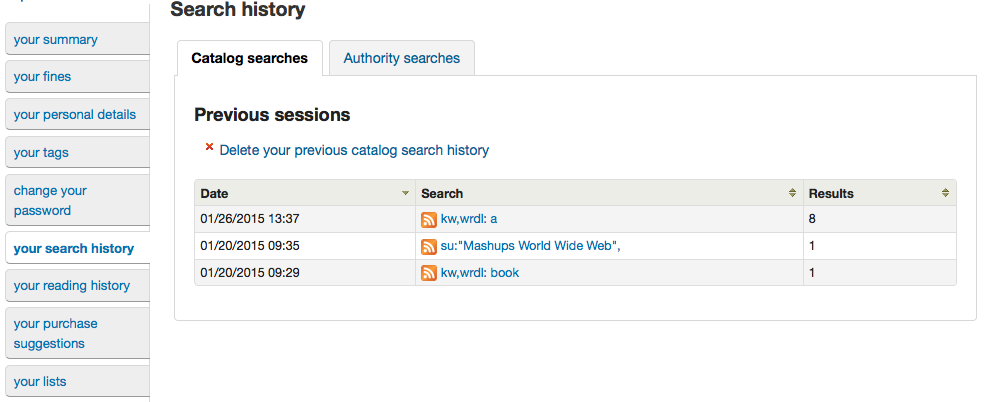
L’historique de recherche affiche tous les termes recherchés par l’adhérent. Si vous cliquez sur l’un des termes, vous relancerez une recherche sur ce terme. L’historique de recherche peut être supprimé par l’adhérent en cliquant sur le lien “Supprimer votre historique de recherche” situé en haut de l’historique ou en cliquant sur la petite “x” rouge située à côté du lien “Historique de recherche” en haut à droite de l’écran.

Your checkout history
Depending on your library’s setting for opacreadinghistory your patrons may see the “your checkout history” tab next. This will show the patron their entire borrowing history unless they have asked the library to not keep that information via the “your privacy” tab which will appear if you have the OPACPrivacy preference set to “Allow.”

Your privacy
The “your privacy” tab will appear if you have both the opacreadinghistory and the OPACPrivacy preferences set to “Allow.” This tab will allow the patrons to decide how the library keeps their circulation history data.
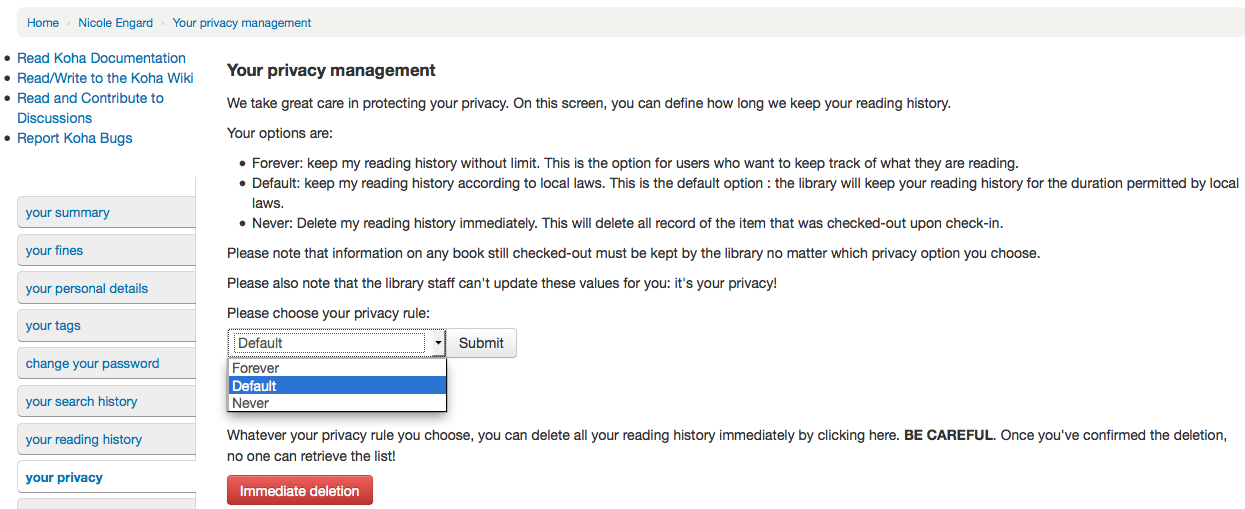
L’adhérent a le choix parmi ces trois options:
Pour toujours : conserver ma liste de lecture indéfiniment.
Défaut : Conserve mon historique de lecture conformément aux lois en vigueur. C’est l’option par défaut. La bibliothèque se chargera de conserver votre historique de lecture pour la durée autorisée par la loi.
Jamais : Efface immédiatement mon historique de lecture. Cela effacera de votre historique tous vos documents empruntés au moment où vous les rendez.
Depending on the patron’s suggestions the contents of the “Your reading history” tab and the “Circulation History” tab in the staff client may change.
Quelque soit le choix de l’adhérent, celui-ci peut supprimer à tout moment son historique de lecture en cliquant sur le bouton “Suppression immédiate”.

Cliquer sur ce bouton ne supprimera pas les prêts en cours mais effacera l’historique de lecture antérieur de l’adhérent.
Important
In order for the patron to be able to delete their reading history you must have the AnonymousPatron preference set.
If you’re allowing guarantees to grand permission to their guarantors to view their current checkouts with the AllowPatronToSetCheckoutsVisibilityForGuarantor preference they will see that option on this screen.
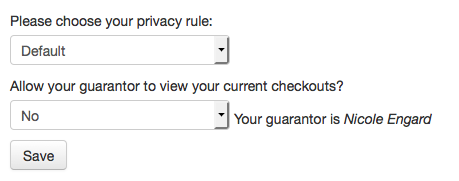
When the guarantor logs in they will see a tab labeled « Relatives” checkouts » on their summary tab.

Your holds history
If the OPACHoldsHistory system preference is set to “Allow”, patrons will be able to see all their current and past holds.
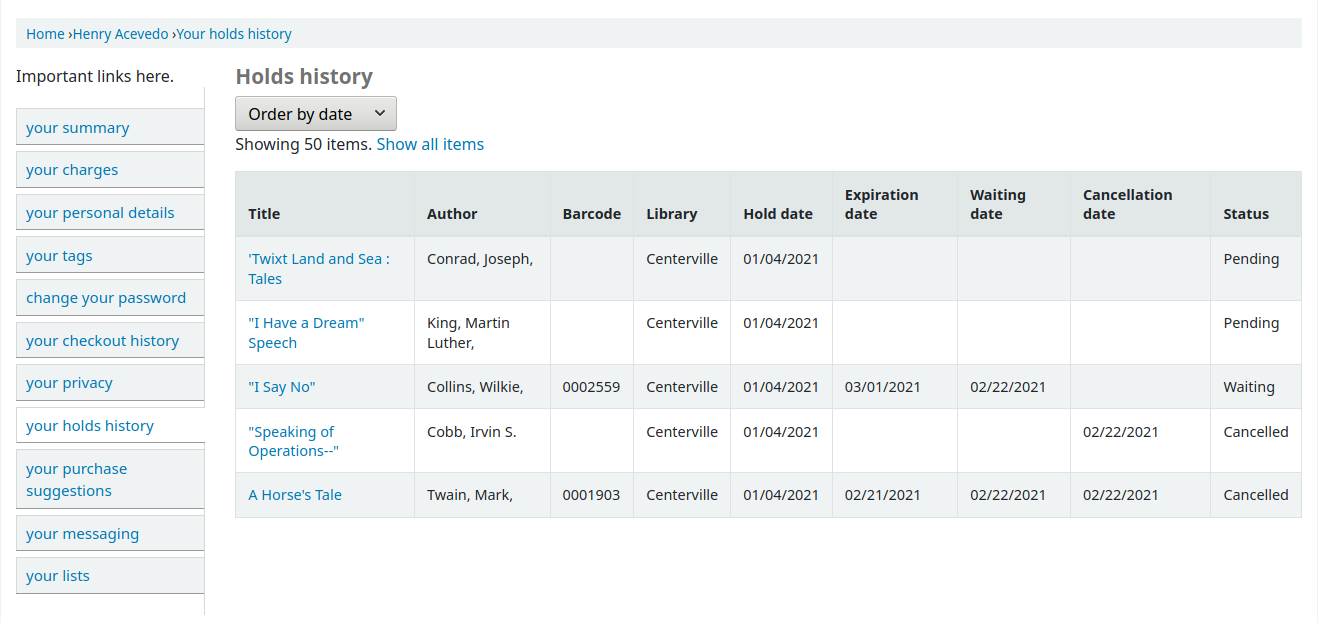
Your purchase suggestions
If your library allows patrons to make purchase suggestions the next tab will show all suggestions that the patron made to the library and their statuses. To disable this tab and the suggestion functionality set the suggestion preference to “Don’t allow.”
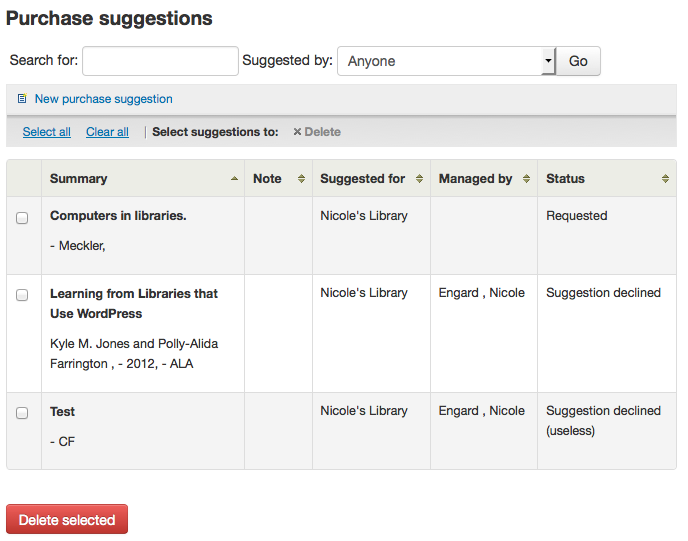
If you have OPACViewOthersSuggestions set to “Show” then patrons will be able to search suggestions from the top of this list.
Your messaging
If your library has the EnhancedMessagingPreferences and the EnhancedMessagingPreferencesOPAC preferences set to “Allow” then your patrons will be able to choose which messages they receive from the library (with the exception of overdue notices which the library controls).
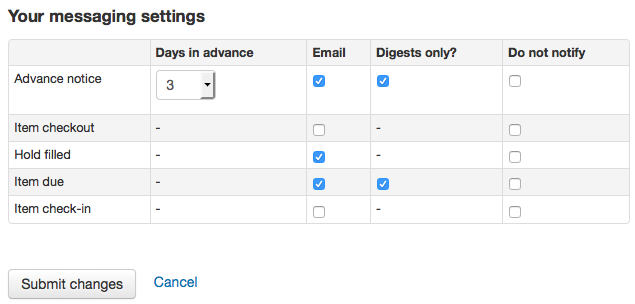
If you use an outside driver for sending text messages set with the SMSSendDriver preference, you will see an additional column to receive these messages as SMS (or text messages) and a field for a cell (or SMS) number.
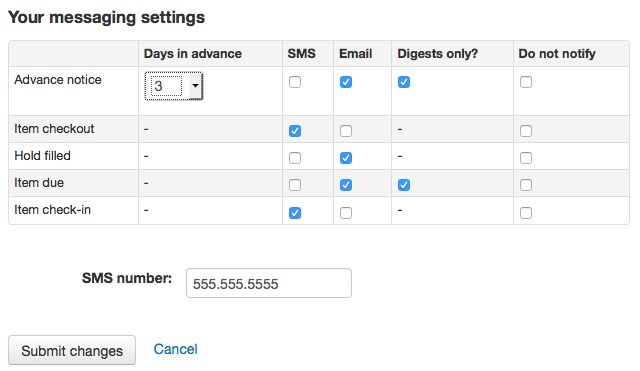
If you are using the Email protocol for sending text messages set with the SMSSendDriver preference, you will see an additional column to receive these messages as SMS (or text messages), a field for a cell (or SMS) number, and a pull down listing cellular providers entered in administration.

If you are using the Itiva Talking Tech service you will see an additional column to receive these messages via Phone.
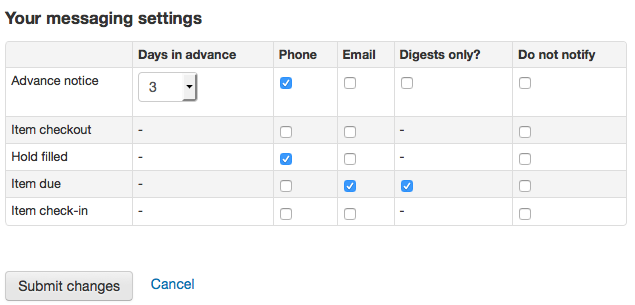
Ces notifications sont:
Advanced notice: A notice in advance of the patron’s items being due (The patron can choose the number of days in advance)
Item checkout: A notice that lists all the of the items the patron has just checked out and/or renewed, this is an electronic form of the checkout receipt
Hold filled: A notice when you have confirmed the hold is waiting for the patron
Item due: A notice on the day and item is due back at the library
Item check-in: A notice that lists all the of the items the patron has just checked in
Les adhérents peuvent choisir de recevoir leurs notifications en un seul résumé en cochant les cases dans “Résumé seulement?”. Ils recevront en un seul email tous les types de messages vus ci-dessus au lieu de plusieurs emails pour chaque alerte.
If the TranslateNotices preference is set to Allow the patron will also see an option to choose “Preferred language for notices” with a dropdown list of available languages.
Important
You must choose a delivery method (SMS or email or phone) along with “Digest only?” if you would like to receive a digest of the messages.
Your lists
If your library has the virtualshelves set to “Allow” they will see the “your lists” tab. From here your patrons can review public lists and create or edit their own private lists.

Ask for a discharge
If you have enabled the useDischarge preference then patrons will be able to request a discharge via the OPAC.
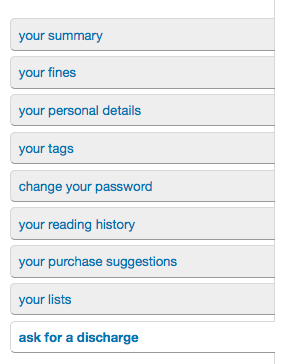
À partir de cet onglet, les adhérents peuvent demander un reçu
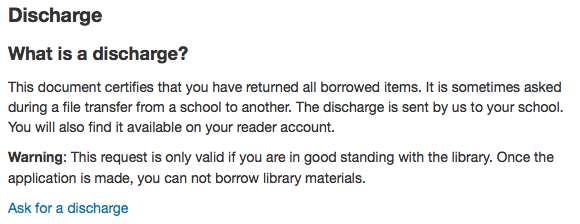
Et vont recevoir une confirmation de leur demande.

Your routing lists
If you are named as a recipient on any serial routing lists you will see them listed here. The following note is displayed « You are subscribed to the routing lists for following serial titles. If you wish to make changes, please contact the library ».
Your interlibrary loan requests
If your library has the ILLModule preference set to ‘Enable’ patrons will have the option to make ILL requests when logged in to their OPAC account. From here they can view their existing requests and place new ones.

To place a new interlibrary loan request click on ‘Create a new request’ and choose a request form.
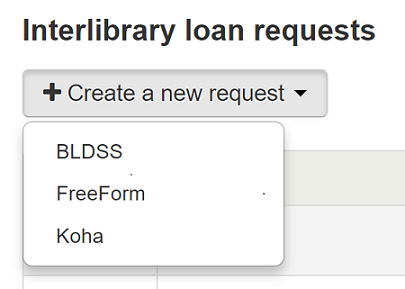
Note
The options displayed are dependent on your ILL configuration. See the ILL backends wiki page at https://wiki.koha-community.org/wiki/ILL_backends further explanation.
Note
If you have entered copyright text in the ILLModuleCopyrightClearance preference the text displays here and you need to click ‘Yes’ to accept before continuing.
Complete the publication details as fully as possible. Depending on the form in use you may see the option to add Custom fields for additional information such as notes. Destination branch is a required field, this is the branch you would like the request to be sent to.
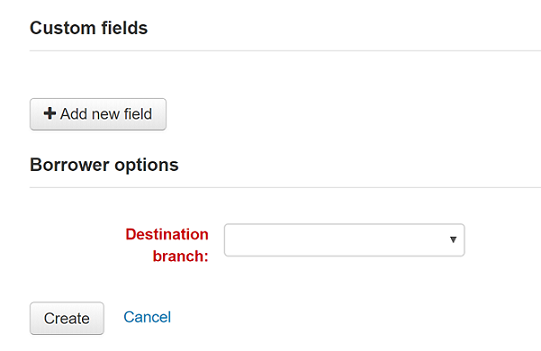
Click on “Create” to submit your request to the library for processing.
Your submitted request will be listed with a status of ‘New request’. Once processed the status will be updated to ‘Requested’.
Click on ‘View’ to make changes or cancel your request.
You cannot edit the form details but you can add a note to request a modification and then click on ‘Submit modifications’ at the bottom of the screen. Your modification will be sent to the library for processing.
For new requests you will also have the option to ‘Request cancellation’. Your request will be updated with the status ‘Cancellation requested’ and can then be removed by library staff.
Your recalls history
If your library allows recalls, the patron can see all their past and current recalls they have requested and their various statuses in the “your recalls history” tab.

The patron can cancel a recall by clicking the “Cancel” button, provided that it is not already awaiting pickup.
Curbside pickups
If your library offers curbside pickup, the patron will be able to see their scheduled pickups under “Curbside pickups”.

The patron has the option to indicate that they are outside the library by clicking “Alert staff of your arrival”.
The patron also has the option to cancel their scheduled pickup with the “Cancel this pickup” button.
If the “Patron-scheduled pickup” setting is turned on in the curbside pickup configuration, the patron will be able to schedule their own curbside pickup appointment.

The patron must first choose a library at which they want to pick up their items
Note
Only libraries with curbside pickup enabled will be displayed in the drop-down menu.
Furthermore, if the “Enable for waiting holds only” setting is turned on, only the libraries at which the patron has waiting holds will be enabled.
The patron must then choose a date
Note
Only dates with available time slots will be displayed.
The possible pickup times will be displayed, depending on the day of the week

Note
The number in parentheses under each time slot is the number of available appointments for that time. If the maximum number of appointments has been reached, based on the “Maximum patrons per interval” setting in the curbside pickup configuration, the time slot will be greyed out and the patron will not be able to select it.
The patron can optionally add a note about their pickup
The patron must then click “Schedule pickup” to save their appointment
Purchase suggestions
If your library has the suggestion preference set to “Allow”, patrons will have the option to make purchase suggestions in several areas in the OPAC.
If you are allowing everyone to see the purchase suggestions made by others with the OPACViewOthersSuggestions preference, there will be a link at the top of your OPAC under the search box.

Un lien s’affichera pour suggérer un achat si l’adhérent ne trouve rien pour sa recherche.

There will be a “Suggest for purchase” option in the detailed view of a bibliographic record.

And there will be a link in the Your purchase suggestions tab in the patron’s account.
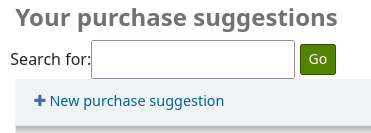
Cliquez sur l’un de ces liens pour ouvrir le formulaire de la suggestion d’achat.
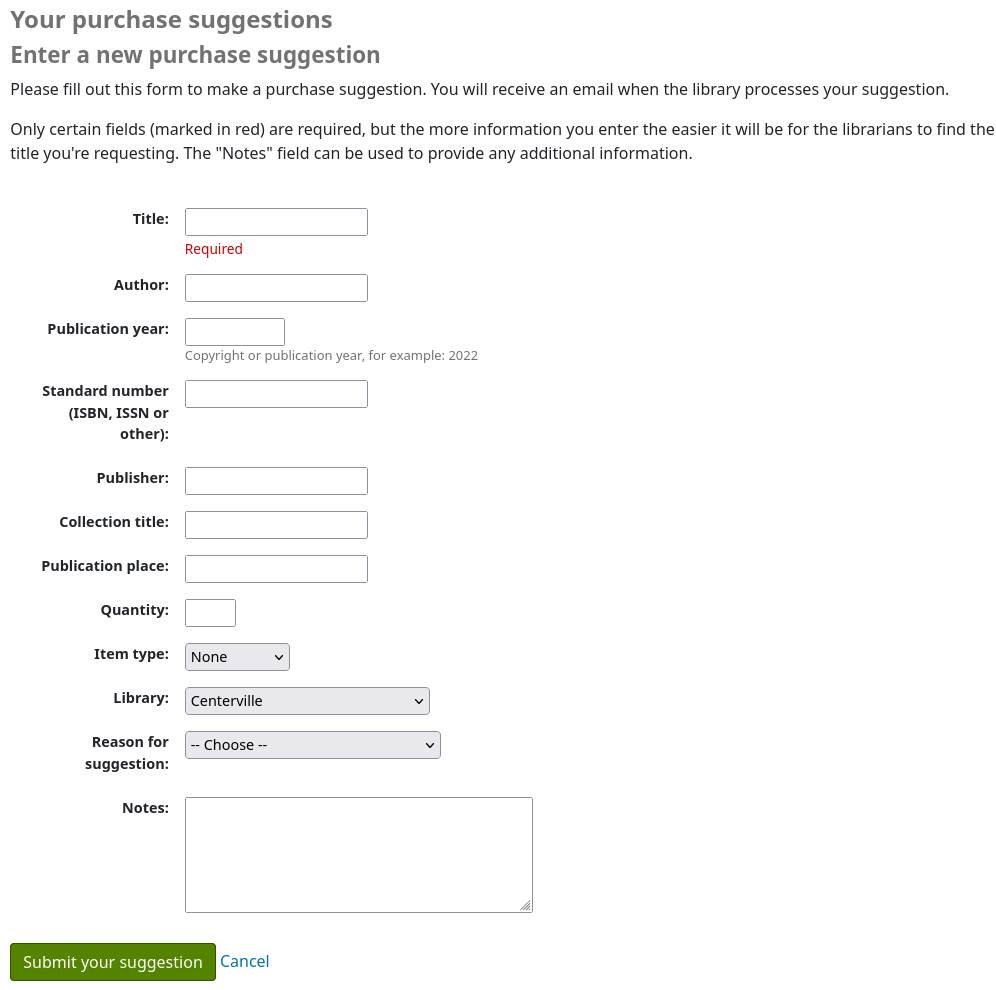
The informational text at the top of the form can be replaced using the HTML customizations tool, display location OpacSuggestionInstructions.
From the form only the “Title” is required by default.
Mandatory fields can be set using the OPACSuggestionMandatoryFields system preference.
The OPACSuggestionUnwantedFields system preference can be used to hide unnecessary fields.
The item type list can be edited by editing the SUGGEST_FORMAT authorized value list.
The “Reason for suggestion” list can be edited by editing the OPAC_SUG authorized value list.
You can change the text at the top of the form using the HTML customizations tool
Once the form is submitted the purchase suggestion will appear in the acquisitions module for the librarians to manage.
If a purchase suggestion has been ordered through the acquisitions module, the patron’s purchase suggestion title will be clickable and bring the patron directly to the ordered record in the OPAC.
Libraries
The “Libraries” page shows the contact information (address lines, city, state, zip/postal code, country, phone number, fax number, website) for libraries in the system that are set as “Public”.
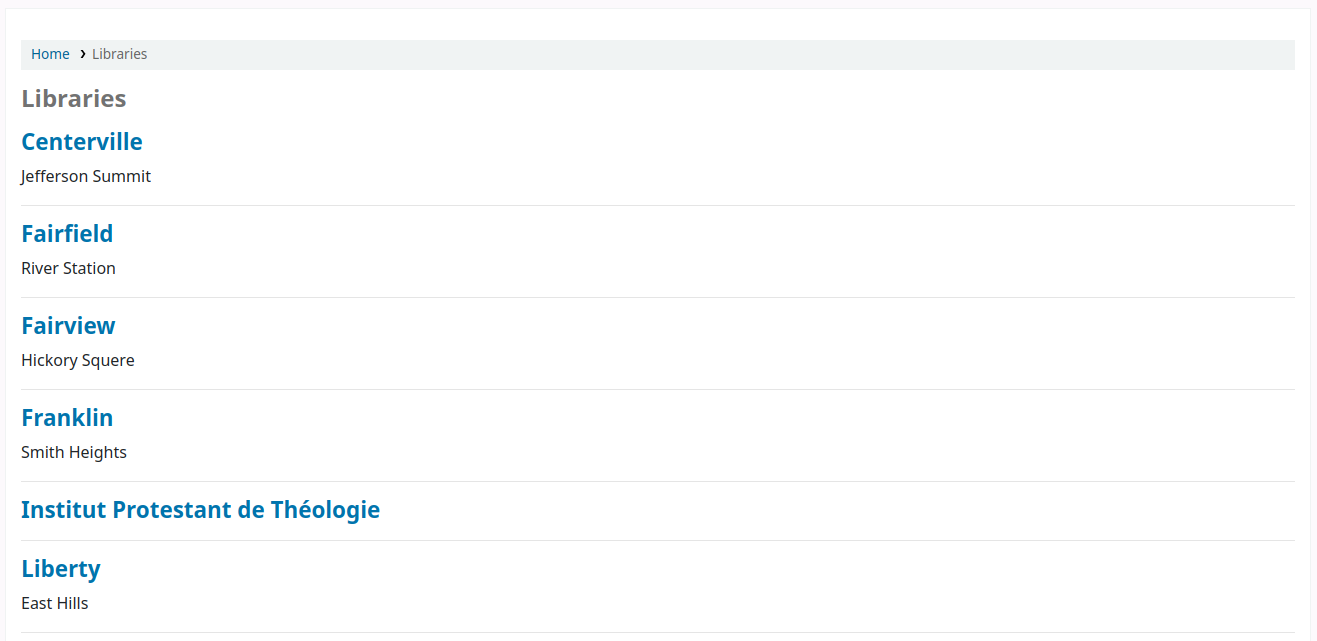
The library name is a link to a specific page for this library. This second page also includes “OpacLibraryInfo” HTML customizations for this library.
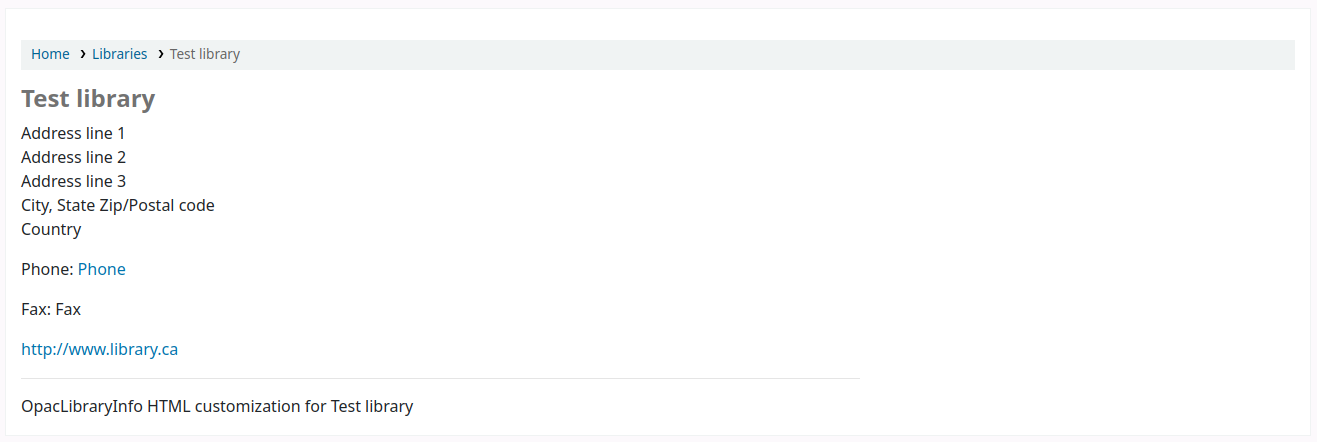
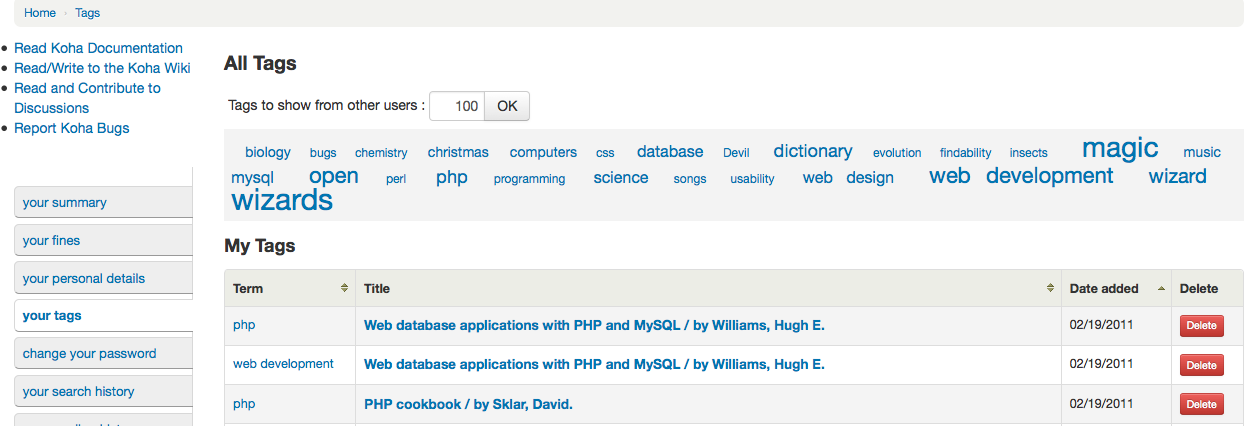
Commentaires
Patrons can leave comments in the OPAC if you have the OPACComments preference set to allow this. Each bibliographic record has a comments tab below the bibliographic information.
Si l’adhérent est connecté sur l’OPAC, il verra un lien pour ajouter un commentaire sur un document. En cliquant dessus cela ouvrira une fenêtre avec un cadre de saisie.
Une fois le commentaire rédigé, cliquez sur le bouton “Valider”. L’adhérent verra son commentaire en attente, et les autres adhérents verront qu’il n’y a aucun commentaire sur le document.
Once the comment is approved the patron will see the number of comments on the “Comments” tab and their comment labeled amongst the other comments. If the ShowReviewerPhoto system preference is set to “Show”, the patron’s photo pulled from the Libravatar library will be displayed next to their comment.
Other patrons will see the comment with the name of the patron who left the comment (unless you have set the ShowReviewer preference to not show patron names).
If you have your OpacShowRecentComments set to show then you’ll see the approved comments on that page.
Depuis cette page, les adhérents peuvent s’abonner aux commentaires récents utilisant le RSS s’ils le souhaitent.